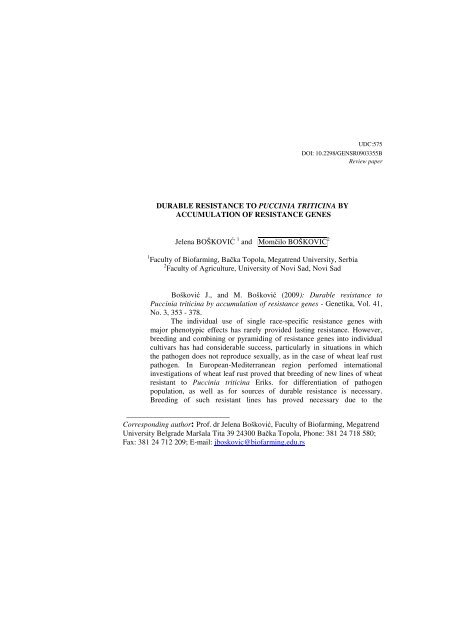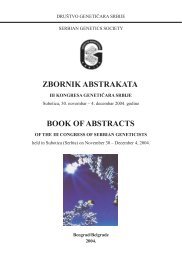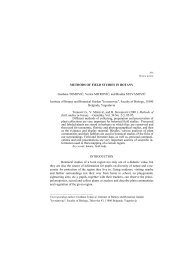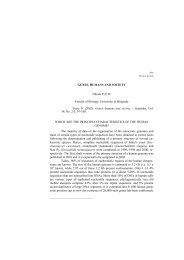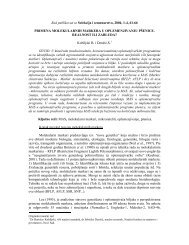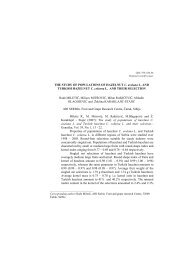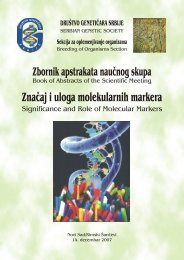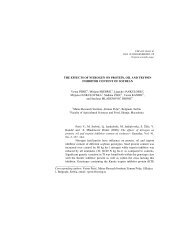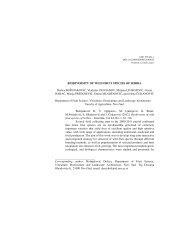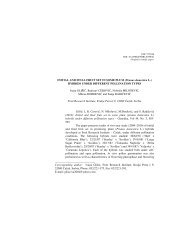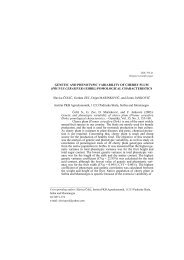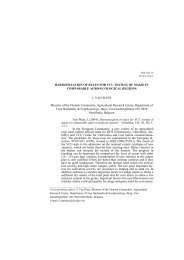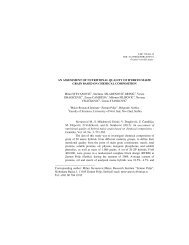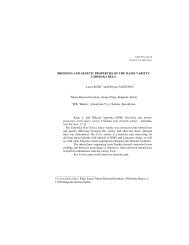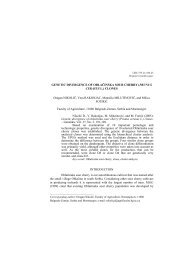Prof. dr Jelena Bošković, Faculty of Biofarming, Megatrend ...
Prof. dr Jelena Bošković, Faculty of Biofarming, Megatrend ...
Prof. dr Jelena Bošković, Faculty of Biofarming, Megatrend ...
You also want an ePaper? Increase the reach of your titles
YUMPU automatically turns print PDFs into web optimized ePapers that Google loves.
UDC:575<br />
DOI: 10.2298/GENSR0903355B<br />
Review paper<br />
DURABLE RESISTANCE TO PUCCINIA TRITICINA BY<br />
ACCUMULATION OF RESISTANCE GENES<br />
<strong>Jelena</strong> BOŠKOVIĆ 1 and Momčilo BOŠKOVIĆ 2<br />
1 <strong>Faculty</strong> <strong>of</strong> Bi<strong>of</strong>arming, Bačka Topola, <strong>Megatrend</strong> University, Serbia<br />
2 <strong>Faculty</strong> <strong>of</strong> Agriculture, University <strong>of</strong> Novi Sad, Novi Sad<br />
<strong>Bošković</strong> J., and M. <strong>Bošković</strong> (2009): Durable resistance to<br />
Puccinia triticina by accumulation <strong>of</strong> resistance genes - Genetika, Vol. 41,<br />
No. 3, 353 - 378.<br />
The individual use <strong>of</strong> single race-specific resistance genes with<br />
major phenotypic effects has rarely provided lasting resistance. However,<br />
breeding and combining or pyramiding <strong>of</strong> resistance genes into individual<br />
cultivars has had considerable success, particularly in situations in which<br />
the pathogen does not reproduce sexually, as in the case <strong>of</strong> wheat leaf rust<br />
pathogen. In European-Mediterranean region perfomed international<br />
investigations <strong>of</strong> wheat leaf rust proved that breeding <strong>of</strong> new lines <strong>of</strong> wheat<br />
resistant to Puccinia triticina Eriks. for differentiation <strong>of</strong> pathogen<br />
population, as well as for sources <strong>of</strong> durable resistance is necessary.<br />
Breeding <strong>of</strong> such resistant lines has proved necessary due to the<br />
___________________________<br />
Corresponding author: <strong>Pr<strong>of</strong></strong>. <strong>dr</strong> <strong>Jelena</strong> <strong>Bošković</strong>, <strong>Faculty</strong> <strong>of</strong> Bi<strong>of</strong>arming, <strong>Megatrend</strong><br />
University Belgrade Maršala Tita 39 24300 Bačka Topola, Phone: 381 24 718 580;<br />
Fax: 381 24 712 209; E-mail: jboskovic@bi<strong>of</strong>arming.edu.rs
354 GENETIKA, Vol. 41, No. 3, 353-378, 2009.<br />
unsatisfatory survey results <strong>of</strong> these regions on standard isogenic Lr lines. It<br />
has become clear that these regions needed new, more efficient differential<br />
resistance genes, as well as sources <strong>of</strong> resistance. In the beginning, after<br />
extensive screening tests <strong>of</strong> several International Rust Nurseries, 18 donors<br />
<strong>of</strong> resistance had been selected as crosses with recurrent parents’ varieties<br />
Princ and Starke. These hybrid lines had been comparatively tested with<br />
twenty six Lr single gene lines using twenty especially virulent cultures <strong>of</strong><br />
P. triticina in order to check the presence <strong>of</strong> these known Lr genes in our<br />
hybrid lines. Considerable influence <strong>of</strong> recurrent parent to the number <strong>of</strong><br />
resistant genes in used donors was demonstrated. On the other hand,<br />
considerable influence <strong>of</strong> the pathogen culture was established to the<br />
number <strong>of</strong> resistance genes in used donors. In order to enhance resistance<br />
and pyramiding genes in these hybrids, the most interesting selected eight<br />
lines have been crossed with only effective isogenic ones, containing the<br />
strong genes Lr9, Lr19 and Lr24. On the basis <strong>of</strong> different segregation<br />
rations <strong>of</strong> all crossing combinations it was proved that no one <strong>of</strong> resistant<br />
donors contained the applied strong resistant genes. It means that our hybrid<br />
lines contained resistant genes from the donors, as well as three strong<br />
resistant genes Lr9, Lr19 and Lr24.<br />
Key words: accumulation <strong>of</strong> resistance genes, hybrid lines, Puccinia<br />
triticina, resistant hybrid, wheat lines.<br />
.INTRODUCTION<br />
Leaf rust, caused by Puccinia triticina Eriks., is an important foliar disease<br />
<strong>of</strong> common wheat (Triticum aestivum L.) worldwide. Breeding wheat cultivars with<br />
resistance to leaf rust is the most effective, economical and environmentally friendly<br />
method <strong>of</strong> disease control and was used in numerous wheat breeding programs<br />
(KOLMER, 1996). Pyramiding several major rust resistance genes into one adapted<br />
cultivar is one strategy for obtaining more durable resistance. Variability <strong>of</strong> wheat<br />
rust pathogen has always represented the greatest problem <strong>of</strong> successful selection <strong>of</strong><br />
resistant cultivars. Sixty years ago international studies <strong>of</strong> wheat rust pathogens and<br />
greater testing <strong>of</strong> resistant genotypes have stated. In 1966 (BOŠKOVIĆ, 1966) in our<br />
country the centre for national and international studies <strong>of</strong> leaf rust pathogens was<br />
founded. During selection for resistance toward leaf rust pathogen, studies have been<br />
carried out in immediate link with the results <strong>of</strong> P. triticina population analysis<br />
results, on national, as well as on international level. Since the very beginning <strong>of</strong> the<br />
forming <strong>of</strong> the international centre for what leaf rust population differentiation,<br />
pathotypes have been used for testing <strong>of</strong> seedlings <strong>of</strong> great number <strong>of</strong> wheat<br />
genotypes and generational material. Beside this, in the international nurseries for<br />
leaf rust numerous lines <strong>of</strong> generational material <strong>of</strong> the selection to resistance were<br />
grown and tested such as in the Central Nursery in Rimski Sancevi. In European –<br />
Mediterranean countries our resistant species were tested in the nursery ELRWN.<br />
In the paper are presented results <strong>of</strong> our long term studies on durable<br />
resistance to wheat leaf rust pathogene Puccinia triticina Eriks.
J.BOŠKOVIĆ AND M.BOŠKOVIĆ: ACCUMULATION OF RESISTANCE GENES 355<br />
Types <strong>of</strong> resistance toward wheat rust pathogens<br />
In 1905. more intensive studies and use <strong>of</strong> resistance toward wheat rust<br />
begun when BIFFEN (1905) proved that resistance toward yellow rust pathogen has<br />
inheritable character. Van der Plank (1963) was the first one who differentiated two<br />
resistance types; specific and horizontal, common or non-specific. Specific type is<br />
the most frequently occurring in plants as hyper sensible reactions and it is efficient<br />
only toward some variants <strong>of</strong> virulent parasites. Hypersensible reactions Gramineae<br />
are causers <strong>of</strong> cell death after infection. This process has been carried out<br />
simultaneously with forming <strong>of</strong> haustoria in host cell (HEAT, 1976). Specific<br />
resistance is preconditioned by one or several genes, while interaction between host<br />
and parasite create gene-for-gene relationships. In praxis it has been proved that<br />
specific resistance has not always been durable. LOEGERING (1961) explained lost <strong>of</strong><br />
resistance in wheat rust by selection pressure and other agents, and it occurs in<br />
shorter or longer time period. In such a manner cultivar Ceres in USA preserved its<br />
resistance toward stem rust pathogen for the period <strong>of</strong> over nine years, while cultivar<br />
Bowie lost the same as soon as its production increased.<br />
Common or non-specific resistance is preconditioned by more minor genes<br />
that take effect to whole pathogen population in longer time interval. In VAN DER<br />
PLANK publication (1984) this resistance type was discussed in more details in<br />
epidemiological sense, but inadequate genetic categorization aroused high<br />
controversy in scientific circles. It has been proved that genetic categorization<br />
sometimes does not correspond to reality. It has been established that resistance is<br />
not <strong>of</strong> polygenetic character but it depends upon one or several specific genes. Good<br />
example for this is resistance <strong>of</strong> all maize lines and hybrids toward Cochliobolis<br />
carbonum U11. It has been assumed that resistance is <strong>of</strong> horizontal character, for it<br />
has been efficient for over thirty years. However, it has been experimentally proved<br />
that it is preconditioned by one mayor gene, which means that it is specific resistance<br />
(SHARP, 1983) Parasite non-specific resistance preconditioned by host’s<br />
morphological or functional characteristics was found, and these act to whole<br />
parasitic population. Similar occurs with excluding leaf rust pathogen from<br />
mechanisms <strong>of</strong> the stoma apparatus (ROMING and COLDWELL, 1964).<br />
Combinations <strong>of</strong> more specific major resistance genes can provide effects<br />
<strong>of</strong> durable horizontal resistance. In India in such a manner wheat cultivars with<br />
combinations Lr1, Lr10, Lr13 and Lr14 preserved resistance in longer time period,<br />
while those with single genes showed higher susceptibility (RAO et al., 1972). Last<br />
years similar resistance effects toward leaf rust pathogen are obtained also by<br />
accumulation, i.e. ‘’pyramiding genes’’ in selection to resistance. Cytoplasm can<br />
also have impact to efficiency and longevity <strong>of</strong> single major genes transferred into<br />
different parents. WASHINGTON and MAN (1974) have proved that the same mayor<br />
resistance gene in wheat cultivar Chris, under influence <strong>of</strong> cytoplasm <strong>of</strong> relatives<br />
Triticum timopheevi and Aegilops speltoides has different longevity and efficiency.<br />
It means that in this case specific major genes can show features <strong>of</strong> horizontal<br />
resistance.
356 GENETIKA, Vol. 41, No. 3, 353-378, 2009.<br />
Example <strong>of</strong> durable gene effect for specific resistance is known in Australia<br />
for Puccinia triticina. Wheat cultivar Timgalen that contained specific genes kSr5,<br />
Sr6 and Sr36 showed resistance in field conditions in the period <strong>of</strong> over twenty<br />
years. In interaction <strong>of</strong> host and parasite horizontal resistance can be defined only in<br />
the case in which specific resistance could not be proved. In terms, in this case the<br />
most suitable expression is type <strong>of</strong> durable resistance that was suggested by JOHNSON<br />
(1983), and it can be <strong>of</strong> specific or horizontal character.<br />
Durable resistance should remain efficient in longer time period under<br />
different environmental conditions (JOHNSON, 1983). Testing to durable resistance<br />
must include two elements, long time period and wide area. It can not be accepted if<br />
the cultivar has been grown in experiments, regardless to the repeated studies at<br />
more localities during several years.<br />
In order to eliminate disadvantages <strong>of</strong> the specific resistance more strategies<br />
have been developed and systematized (MAC KAY, 1987). Breeding <strong>of</strong> resistant<br />
cultivars by synthesis has been stipulated first, i.e. by building in <strong>of</strong> several<br />
resistance genes into one cultivar. It can give efficient protection in longer time<br />
period for the appropriate spectrum <strong>of</strong> pathogen virulence. This approach would<br />
comprehend also combination <strong>of</strong> specific genes that in interaction with the parasite<br />
maintain significantly lower infection type in regard to genes used as single ones<br />
(SOMBORSKI and DYCK, 1982).<br />
NELSON (1978) named synthesis <strong>of</strong> specific resistance genes ‘’pyramiding<br />
genes’’. KOLMER et al. (1991) emphasized that the most significant strategy has been<br />
selection to durable resistance <strong>of</strong> pyramiding genes. Certain programs that have been<br />
directed to combination <strong>of</strong> genes proved very successful in increase <strong>of</strong> durable<br />
resistance (ROELFS et al., 1992). With gene accumulation more durable resistance<br />
has been maintained, for there have been small possibilities <strong>of</strong> corresponding<br />
virulence gene mutations in pathogen population (MUNDT, 1990). Durable resistance<br />
that lasted in the period 1966 – 1980 (KOLMER et al., 1991) toward leaf rust has been<br />
stipulated for cultivars Chris, Era (Lr13+Lr34) and Columbus (Lr13+Lr16). In our<br />
breeding program we have been oriented toward accumulation <strong>of</strong> the most efficient<br />
strong genes and their wild relatives Lr9, Lr19 and Lr24. Many wheat lines <strong>of</strong> high<br />
specific resistance that gave very good results in longer time period on wide<br />
European-Mediterranean region were made (BOŠKOVIĆ et al., 1995; 1996; 1999;<br />
2001).<br />
The second variant <strong>of</strong> synthesis has been directed toward use <strong>of</strong> moderate,<br />
i.e. mean efficient specific resistance toward whole spectrum <strong>of</strong> virulence, by which<br />
selection pressure <strong>of</strong> host to parasitic population has been slowed-down. ZADOKS<br />
(1972) described similar type <strong>of</strong> resistance also in the system Triticum: Puccinia<br />
striiformis Westend.<br />
The following approach refers to use <strong>of</strong> specific resistance genes with<br />
differentiation in time. Successive change <strong>of</strong> single genes enables stabilization <strong>of</strong><br />
selective pressure to the pathogen population. In such cyclic changes identical genes<br />
can be used again after appropriate number <strong>of</strong> years (VAN DER PLANK, 1982).
J.BOŠKOVIĆ AND M.BOŠKOVIĆ: ACCUMULATION OF RESISTANCE GENES 357<br />
The last approach comprises in creation <strong>of</strong> spatial genetic diversity that can<br />
successfully counteract diversified virulence inside pathogen population. This is<br />
maintained by growing <strong>of</strong> multi-line, compound cultivars or by coordinated use <strong>of</strong><br />
different resistance genes in certain geographic areas. Multi-line or compound<br />
cultivars attracted greater attention by way <strong>of</strong> creation and practical use. BORLAUG<br />
(1958) was the first one to initiate the idea <strong>of</strong> creation <strong>of</strong> these wheat cultivars in<br />
control <strong>of</strong> pathogen epidemics. Multi-line cultivar compiles <strong>of</strong> agronomic similar<br />
isogenic lines with differing resistance genes that should maintain parasite<br />
equilibrium. BORLAUG and GILBER (1953) used modified crossing method for<br />
creation <strong>of</strong> multi-line wheat cultivars against P. graminis tritici. BROWING and FREY<br />
(1969) distinguish that multi-line cultivars posses not only vertical but horizontal<br />
resistance as well, even tolerance. Many works in selection were directed to creation<br />
and growing <strong>of</strong> mutli-line cultivars and their mixtures with the aim <strong>of</strong> obligatory<br />
parasite control. Multi-line cultivars have not been made especially for P. triticina.<br />
Delayed sporulation <strong>of</strong> what rust pathogen is considered as very valuable<br />
characteristics <strong>of</strong> horizontal resistance type. ZADOKS (1972) analyzed components <strong>of</strong><br />
horizontal type <strong>of</strong> resistance toward P. triticina in great number <strong>of</strong> wheat genotypes<br />
under identical conditions <strong>of</strong> inoculation. He found great differences between<br />
cultivars in pustule number and size, as well as in dynamic <strong>of</strong> pathogen penetration<br />
per unit <strong>of</strong> leaf area. Differences were also found between length <strong>of</strong> incubation<br />
period, sporulation dynamic, pustule development and infective period. Grater<br />
number <strong>of</strong> authors (PARLEVLIET, 1975, GUPTA and SINGH, 1982) differentiated<br />
components <strong>of</strong> delayed development <strong>of</strong> wheat and barley parasites; the frequency <strong>of</strong><br />
infection, prolonged incubation period (latent period), size <strong>of</strong> a pustule and number<br />
<strong>of</strong> uredospores per pustule. Winter and summer wheat cultivars with delayed<br />
development <strong>of</strong> leaf rust significantly delay also epidemic in field. Delayed<br />
development <strong>of</strong> leaf rust parasite is more present in summer wheat cultivars. BJARKO<br />
and LINE (1986) established that this is horizontal type <strong>of</strong> resistance conditioned by<br />
three partially recessive genes. From the practical point <strong>of</strong> view significantly more<br />
valuable are cultivars with accumulation <strong>of</strong> resistance genes, for horizontal<br />
resistance does not <strong>of</strong>fer complete protection (ROELFS et al., 1992).<br />
Partial resistance is the most important feature <strong>of</strong> horizontal resistance type,<br />
and it is expressed by significantly reduced diseases intensity, which results also<br />
with minor damages. In interaction <strong>of</strong> oat and Puccinia hordei Otth. basic<br />
component has partially extended period <strong>of</strong> incubation due to which number <strong>of</strong> rust<br />
uredo generations is reduced (PARLEVLIET, 1981). Studies have shown that this<br />
interaction causes mechanism <strong>of</strong> excluding parasite before forming haustoriae (NIKS,<br />
1986). The author reported that partial resistance originates from association<br />
between reduction <strong>of</strong> forming haustoriae and reduction <strong>of</strong> infection without death <strong>of</strong><br />
cells due to hyper sensible reaction. Presence <strong>of</strong> the susceptible infection type<br />
(PARLEVLIET and OMMEREN, 1875) results in great reduction in development <strong>of</strong><br />
epidemics. Retarded fungi development after forming <strong>of</strong> haustoriae has been noticed,<br />
as well as smaller pustules at seedlings and adult plants (JACOBS, 1989). All listed<br />
components <strong>of</strong> the partial resistance are included in extended incubational period
358 GENETIKA, Vol. 41, No. 3, 353-378, 2009.<br />
(LP), and it is the most important in wheat infected by rust parasites (TANG et al.,<br />
1977). In interaction <strong>of</strong> oat and Puccinia hordei inheritance <strong>of</strong> prolonged<br />
incubational period is preconditioned by several genes <strong>of</strong> minor effect, and majority<br />
<strong>of</strong> them express additive action (PARLEVLIET, 1981). For prolonged incubational<br />
period in system Triticum aestivum: Puccinia triticina, LEE and SHANER (1985)<br />
determined oligogenic inheritance two <strong>of</strong> four recessive genes with the identical<br />
effects. Two partially recessive resistance genes for LP have been reported for wheat<br />
genotype Suwon 85 as well (KUHN et al., 1980).<br />
Tolerance is the special type <strong>of</strong> resistance. Tolerant genotype is able to<br />
sustain corresponding infection level with significantly lower yield losses in contrast<br />
to other genotypes under identical conditions. For tolerance and horizontal resistance<br />
mutual feature is absence <strong>of</strong> specific selective pressure to the parasite population.<br />
Difference make occurrence <strong>of</strong> horizontal resistance from special natural obstacles <strong>of</strong><br />
parasite development, while tolerance refers to adaptation <strong>of</strong> metabolism and<br />
energetic production <strong>of</strong> the host. Genetic bases <strong>of</strong> tolerance almost always have<br />
polygenic character, as it includes adaptation <strong>of</strong> whole host plant mechanism<br />
(SCHAFER, 1971). It has been defined (SCHAFER, 1971), but they have all accepted<br />
that tolerant cultivar suffers significantly lower losses in yield and quality. Selection<br />
to tolerance towards obligate and facultative parasites is very difficult, for it has not<br />
been able to select and valuate material in generations <strong>of</strong> segregation. Selection to<br />
tolerance in some fungi and bacteria has been methodologically successful. SOTO et<br />
al. (1982) emphasizes that selection to tolerance can be successful in virus diseases<br />
that are transmitted by insects-vectors. Tolerance has been demonstrated by several<br />
authors in field trials, but there have not been special studies <strong>of</strong> physiology <strong>of</strong> mutual<br />
relationships <strong>of</strong> parasites and hosts. Due to this, selection in direction <strong>of</strong> tolerance<br />
arise special difficulties. BELL (1968) emphasizes that only knowledge <strong>of</strong><br />
physiological causes <strong>of</strong> this phenomenon would enable direction <strong>of</strong> selection toward<br />
causing physiological processes related to tolerance. Tolerance toward P. triticina<br />
has been evaluated as in cases <strong>of</strong> other parasites by comparison <strong>of</strong> infection intensity<br />
and yield.<br />
Finally, type <strong>of</strong> resistance that is based upon the mechanism <strong>of</strong> avoiding <strong>of</strong><br />
the infection by host should be mentioned. This kind <strong>of</strong> resistance occurs when<br />
susceptible host stadium develops before occurrence <strong>of</strong> parasites and mass<br />
development <strong>of</strong> inoculums, as well as the most intensive attack. This resistance type<br />
is called pseudo-resistance. COLDWELL et al. (1957) have found that wheat cultivar<br />
Dual avoids harder infection <strong>of</strong> P. triticina, with only 4% <strong>of</strong> infected plants, whereas<br />
cultivar Trumbull had 90% infected ones.<br />
Inheritance modes <strong>of</strong> wheat resistance to Puccinia triticina<br />
Since the very beginning (MAINS et al., 1926), studies <strong>of</strong> P. triticina<br />
resistance inheritance have provided basic scientific information for selection to<br />
resistance. MARTINEZ et al. (1953) performed comprehensive inheritance studies <strong>of</strong><br />
resistance toward some parasite races in stadium <strong>of</strong> seedlings and adult plants, in<br />
combination <strong>of</strong> resistant wheat genotype NS No. II-39-2 (Premier x Bobin-Gaza-
J.BOŠKOVIĆ AND M.BOŠKOVIĆ: ACCUMULATION OF RESISTANCE GENES 359<br />
Bobin) with susceptible cultivar Thatcher. Seedlings reactions depended upon two<br />
pair <strong>of</strong> resistance genes toward only some races, whereas field reactions were<br />
preconditioned with three pairs <strong>of</strong> genes.<br />
Inheritance <strong>of</strong> resistance to several races <strong>of</strong> P. triticina was studied by<br />
FITZERALD et al. (1957) in combination <strong>of</strong> crossing <strong>of</strong> resistant wheat genotype<br />
Purdue Sel. 3369-61-1-10 with the cultivars AmBanner, Butler, Wabash, Seneca and<br />
Malak<strong>of</strong>. In some combinations <strong>of</strong> this crossings resistance depended upon two<br />
genes and it was inherited dominantly toward four races and recessively toward one.<br />
Other combinations indicated monogenetic inheritance. Depending upon races and<br />
parents pair’s inheritance, resistance can depend upon one, two or three gene pairs<br />
(ALAN et al., 1959). SCHAFER et al., (1963) showed that incorporation <strong>of</strong> two or more<br />
resistance genes in one cultivar is much better, as parasite needs more virulence<br />
mutations to overcome this resistance.<br />
For inheritance <strong>of</strong> resistance <strong>of</strong> the mature plant stadium for cultivars Rio<br />
Negro and Frondozo two complementary genes were established (RAO et al., 1962).<br />
Studies <strong>of</strong> UPADHYAYA et al., (1965) showed that in some crossings <strong>of</strong> three<br />
dominant resistance genes two proved to be complementary. Two complementary<br />
dominant and one recessive resistance gene were established in other crossing<br />
combinations. It was emphasized that modification genes are important for reaction<br />
toward P. triticina in the stadium <strong>of</strong> adult plants, but very susceptible to the<br />
influence <strong>of</strong> environmental factors (DYCK, 1987). Authors identified partially<br />
dominant resistance genes <strong>of</strong> the adult stadium Lr12 in the cultivar Exchange and<br />
Lr13 in the cultivar Frontana. In the same cultivar, beside gene Lr13 Frontana it was<br />
also found genes Lr1 and Lr15. It should be emphasized that this resistance <strong>of</strong> adult<br />
plants has been insufficiently studied regardless <strong>of</strong> the fact that for some <strong>of</strong> these<br />
resistance were established as monogenetic type and dependant upon single genes<br />
Lr12,13, 22a, 2b and 26 (ROELFS, 1984).<br />
Inheritance <strong>of</strong> resistance in adult plants to cultivars, P. triticina was studied.<br />
Combinations <strong>of</strong> resistance genes <strong>of</strong> seedlings with genes resistance <strong>of</strong> adult plants<br />
are known. Lr1 and Lr10 stipulate resistance <strong>of</strong> seedlings, and Lr 22a is especially<br />
efficient in the stadium <strong>of</strong> third and fourth pair <strong>of</strong> leaves (BROWDER, 1980). The<br />
same, LrT2 with reaction <strong>of</strong> medium resistance <strong>of</strong> seedlings gives high resistance in<br />
the stadium <strong>of</strong> adult plants in the field (SAMBORSKI and DYCK, 1982). The same<br />
authors emphasize that LrT2 and Lr13 in interaction with other resistance genes<br />
influence to the significant increase <strong>of</strong> resistance level toward leaf rust pathogen.<br />
However, more resistance components <strong>of</strong> the adult plant stadium that are not<br />
sufficiently differentiable do not exist, especially when related to the influence <strong>of</strong><br />
host development stadium, nutrition, quantity <strong>of</strong> inoculums, temperature and light<br />
(ROELFS, 1984). RUSSELL et al., (1976) proved differences in expression <strong>of</strong> resistance<br />
<strong>of</strong> the adult plant stadium in wheat in interaction <strong>of</strong> host and pathogen.<br />
In characterization <strong>of</strong> wheat resistance to leaf rust parasite MILUS and LINE<br />
(1980) identified seven resistance classes in the study <strong>of</strong> four components in the<br />
stadium <strong>of</strong> seedlings and adult plants. Phenotypically, these classes incorporated<br />
susceptibility, hyper sensibility and different levels <strong>of</strong> retarded growth <strong>of</strong> rust
360 GENETIKA, Vol. 41, No. 3, 353-378, 2009.<br />
included in resistance <strong>of</strong> adult plants. MODAWI et al. (1985) established that in<br />
susceptible cultivars Belinda and Thatcher in adult stadium <strong>of</strong> development<br />
significant reduction in number <strong>of</strong> uredopustals per cm 2 <strong>of</strong> the wheat flag leaf area.<br />
According to MILUS and LINE (1980), retarded development <strong>of</strong> leaf rust as<br />
the basic component <strong>of</strong> resistance <strong>of</strong> adult plant stadium, can be easily identified in<br />
majority <strong>of</strong> wheat genotypes. According to some author, retarded development <strong>of</strong><br />
leaf rust is inherited monogenetically or oligogenically (LEE and SHANER, 1985,<br />
JERKOVIĆ, 1992, PRIJIĆ and JERKOVIĆ, 2009), and it means that this form <strong>of</strong><br />
resistance can be easily manipulated in breeding programs. Quantitative character <strong>of</strong><br />
inheritance <strong>of</strong> retarded development <strong>of</strong> leaf rust was also reported. Inheritance <strong>of</strong> the<br />
prolonged incubational period (LP) in interaction <strong>of</strong> oat and leaf rust parasite P.<br />
hordei depends upon several genes with additive action. LEE and SHANER (1985)<br />
determined the oligogenetic inheritance <strong>of</strong> LP length in six wheat genotypes with<br />
retarded leaf rust development. Two to four partially recessive genes with identical<br />
effects for prolonged incubational period (LP) P. triticina were determined. KUHN et<br />
al., (1980) found two partially dominant resistance genes with the identical effects in<br />
resistance inheritance <strong>of</strong> prolonged incubational period for the wheat cultivar Suwon<br />
85. Similarly, BJARKO and LINE (1986) established two to three partially recessive<br />
genes for inheritance <strong>of</strong> this trait.<br />
Models <strong>of</strong> gene-for-gene relationship host: pathogen<br />
Based upon FLOR’S (1956) hypothesis, PERSON (1959) was the first one to<br />
develop theoretical model in the system gene-for-gene including five corresponding<br />
gene pairs (CGP) and by this he provided new directions in data analysis <strong>of</strong> infection<br />
types (IT) <strong>of</strong> rust parasites. Basic rule in the model was that genes for resistance and<br />
genes for virulence result in the type <strong>of</strong> susceptibility. The author determined host<br />
genotypes based upon increasing number <strong>of</strong> genes for resistance, pathogen genes<br />
based upon increasing number <strong>of</strong> genes for virulence, and these relationships were<br />
mathematically processed in details.<br />
In the model <strong>of</strong> ROBINSON (1980) was applied the identical Person’s rule, by<br />
which resistance genes <strong>of</strong> hosts and genes <strong>of</strong> high pathogenisity <strong>of</strong> parasites result in<br />
susceptible infection types, but with differently classified genotypes. The author<br />
assorted all alleles as susceptible as well as resistant reactions at the identical locus.<br />
The other gene assortments at corresponding locuses that differ from Person’s model<br />
were given. In any case, Robinson’s arrangements <strong>of</strong> genotypes <strong>of</strong> host and parasite<br />
interaction provide higher basis for logical approach to analysis <strong>of</strong> phenotypic data<br />
(IT) in gene-for-gene system. However, his arrangements <strong>of</strong> interaction genotypes<br />
are not based upon bionomical widening proposed by PERSON (1959). ROBINSON<br />
(1980) suggested that there exist other mathematical relationships that can be applied<br />
during classification <strong>of</strong> genotypes based upon nature <strong>of</strong> alleles at each locus.<br />
MCINTOSH and WATSON (1982) broadened gene-for-gene relationship model<br />
in another manner. In their models, only two corresponding gene pairs are treated,<br />
but genes <strong>of</strong> low pathogenisity and genes that lead to reaction characteristic for<br />
resistant plants that in interaction provide low infection type (IT) are assorted.
J.BOŠKOVIĆ AND M.BOŠKOVIĆ: ACCUMULATION OF RESISTANCE GENES 361<br />
Boolean’s model is based upon concept <strong>of</strong> agricorpus. This model applies<br />
Boolean’s algebra symbolization that is very useful, as there are no traditional<br />
mathematic or biological marks. It has its special genotype that is integration <strong>of</strong><br />
parasite and host interaction, and agricorpus phenotype qualifies its genotype.<br />
LOEGERING et al., (1971) developed computerized method <strong>of</strong> grouping host lines<br />
toward their reaction to the corresponding parasite culture out <strong>of</strong> which conclusions<br />
upon host and parasite genotypes can be made. Agricorpus possesses genotype<br />
which is interaction <strong>of</strong> host and parasite, and phenotype is preconditioned by<br />
agricorpus genotype (LOEGERING, 1984). This leads to the conclusion that genetic <strong>of</strong><br />
agricorups is needed as well as genetic <strong>of</strong> host and parasite, and that it specially<br />
categorizes genetic between organisms and genetic within them. In this system<br />
interaction <strong>of</strong> host and parasite genotype toward relationships gene-for-gene and<br />
with use <strong>of</strong> the above given symbols can be presented by Boolean’s scheme.<br />
Symbols in the scheme clearly suggest that for definite phenotype <strong>of</strong> agricorpus,<br />
definite genotype <strong>of</strong> parasite as well as <strong>of</strong> host are needed, and it is the essence <strong>of</strong> the<br />
gene-for-gene concept. In such a manner it can be determined if two or more host<br />
lines differ in pathogenisity genotype. It is assumed that two host lines or two<br />
parasite cultures have alleles for reaction, or alleles for patogenisity. Definitive<br />
phenotype in wheat rust is usually connected with resistance, while in interaction <strong>of</strong><br />
some other parasites and host exist exceptions.<br />
Many studies have shown that the plant infected by rust parasites resistant<br />
at moderate temperatures become susceptible at significantly higher ones. Most <strong>of</strong><br />
the authors related these changes in response to host resistance genes, which are<br />
called "temperature genes" (EYAL and PETERSON, 1967).<br />
Wheat allele Lr13 for resistance to Puccinia triticina in adult plant stadium,<br />
can be found in stadium <strong>of</strong> seedlings when plants are inoculated with the<br />
corresponding culture <strong>of</strong> parasites at 25.5 0 C. Also, resistance gene <strong>of</strong> adult plant<br />
stadium <strong>of</strong> wheat cultivar Atlas 66 was found with some cultures <strong>of</strong> Puccinia<br />
triticina at 5 0 C, at it was not discovered with identical cultures at 19 0 C. Delayed<br />
parasite development <strong>of</strong> wheat rust parasites in cultivar Suwaon 85 can be even<br />
visually observed when infected seedlings are grown at 5 and 12 0 C, but not when<br />
grown at 19 and 26 0 C (BROWDER and EVERSMEYER, 1984).<br />
LOEGERING (1984) has already emphasized in Boolean’s model great<br />
influence <strong>of</strong> temperature to agricorpus phenotype, but he has not incorporated this<br />
influence into logical symbols <strong>of</strong> the system. Other mathematical models for genetic<br />
interaction between plant population and their parasite have also been known.<br />
Sources <strong>of</strong> resistance and Puccinia triticina pathotypes<br />
In 1966. in Novi Sad the International European Centre for Wheat Rust was<br />
founded (BOŠKOVIĆ, 1966). Since then, extensive testing <strong>of</strong> the world germ-plasm,<br />
i.e. <strong>of</strong> International wheat rust nurseries as Yugoslav selection materials in the<br />
Central nursery for wheat rust in Rimski Sancevi have been carried out. In this<br />
nursery genotypes in adult plant stadiums under conditions <strong>of</strong> artificial inoculations<br />
have been tested. In a greenhouse the identical wheat genotypes in the stadium <strong>of</strong>
362 GENETIKA, Vol. 41, No. 3, 353-378, 2009.<br />
seedlings with the European pathotypes Puccinia triticina have been tested<br />
(BOŠKOVIĆ, 1980). Based upon obtained results <strong>of</strong> these testings, resistance sources<br />
have been chosen, as well as the other resistant wheat genotypes for European Leaf<br />
Rust Wheat Nursery (ELRWN).<br />
After many years <strong>of</strong> testing in the central nursery in such a manner two groups<br />
<strong>of</strong> genetically different sources <strong>of</strong> resistance have been selected to wheat rust<br />
pathogen. The first group <strong>of</strong> eight sources <strong>of</strong> resistance exhibited greater genetic<br />
differentiations and it has been used for complex breeding. In the second group eight<br />
other sources <strong>of</strong> resistance have been included that participated only in the first<br />
phase <strong>of</strong> breeding. At the time wheat cultivar Sava from Novi Sad was resistant, and<br />
was used as a control genotype.<br />
Majority Lr isogenic lines selected up to 1980 showed susceptibility toward<br />
European pathotypes, i.e. races <strong>of</strong> Puccinia triticina (BOŠKOVIĆ 1971, 1976, 1980,<br />
1988; BOŠKOVIĆ and BROWDER, 1976).<br />
Transfer <strong>of</strong> resistance genes toward P. triticina into identical recurrent parents<br />
1980. in cooperation with <strong>Pr<strong>of</strong></strong>. Mac Kay from Sweden begun breeding<br />
program <strong>of</strong> creation <strong>of</strong> European resistant lines toward Puccinia triticina, by transfer<br />
<strong>of</strong> new, more efficient genes into identical recurrent parents. Hybrid combinations <strong>of</strong><br />
the first back-crossing (F1b1) <strong>of</strong> the first group <strong>of</strong> eight resistance sources with<br />
cultivars Prince and Starke were tested in stadium <strong>of</strong> seedlings with three<br />
international cultures P. triticina (BOŠKOVIĆ et al., 1998; 2001; 2006).<br />
Cultures <strong>of</strong> the resistant type <strong>of</strong> reaction ‘’1’’ were taken from strong genes <strong>of</strong> wide<br />
spectrum Lr9 and Lr19, as these are more virulent. Hybrid material from these<br />
crossings is grown and tested in the Central Nursery in Rimski Sancevi with use <strong>of</strong><br />
the pedigree method <strong>of</strong> breeding <strong>of</strong> resistant <strong>of</strong>fspring in conditions <strong>of</strong> artificial<br />
nursery inoculations.<br />
Relationship <strong>of</strong> segregation with the culture Yu-13-19-1 with each <strong>of</strong> eight<br />
resistance sources (66,77,26,32,37,49, 95,146) have shown that line 66/2 with<br />
recurrent parent Princ segregated to two resistance genes, and hybrid 66/4 with the<br />
cultivar Starke showed activity <strong>of</strong> three resistance genes. This relation <strong>of</strong> segregation<br />
suggests that there exist complementary action <strong>of</strong> genes. Significance <strong>of</strong> recurrent<br />
parent has been noticed, as the identical source <strong>of</strong> resistance with the cultivar Princ<br />
showed two resistance genes, and with the cultivar Starke three genes. In contrast to<br />
these, two hybrids <strong>of</strong> the following hybrid combinations: 77/1 x Princ and 77/3 x<br />
Starke, as well as I 32/2 x Prince and 32/3 x Starke have shown presence <strong>of</strong> only one<br />
resistance gene in both recurrent parents. The identical combinations <strong>of</strong> resistance<br />
genes occurred in lines 26/1 x Prince and 26/2 x Princ x Starke in regard to hybrids<br />
94/1 x Princ and 94/2 x Starke. Both sources (26 and 94) with Prince had one<br />
resistance gene, and identical sources with Starke had two resistance genes. Three<br />
resistance genes have been determined in relationships <strong>of</strong> segregation lines 37/2 x<br />
Princ and 37/3 x Starke, and two resistance genes in hybrids 146/3 x Princ and 146/1<br />
x Starke. The influence <strong>of</strong> the recurrent parent in line 46/2 x Princ with two<br />
resistance genes toward line 46/1 x Starke with one gene has shown again.
J.BOŠKOVIĆ AND M.BOŠKOVIĆ: ACCUMULATION OF RESISTANCE GENES 363<br />
The relationship <strong>of</strong> segregation with another culture H-13-9-1 revealed no<br />
differences between the parents in the recurrent parents in crossing combinations<br />
77/1 x Princ and 77/3 x Starke, followed by 37/2 x Princ and 37/3 x Starke, as well<br />
as 146/3 x Princ and 146/1 x Starke. For these hybrid combinations the identical<br />
results were achieved with both <strong>of</strong> the used pathotypes. Namely, both recurrent<br />
parents with a source <strong>of</strong> resistance 77 showed the presence <strong>of</strong> one gene, and with the<br />
source 37 three resistance genes and the source 146 two resistance genes. The<br />
identical results for both cultures were obtained by remaining hybrids, except lines<br />
32/2 x Princ and 32/2 x Starke. The first one segregated in the presence <strong>of</strong> one, and<br />
the second in the presence <strong>of</strong> three resistance genes with complementary effect.<br />
Analysis <strong>of</strong> segregation toward the third culture CZ-13-Ar-3 to the number<br />
<strong>of</strong> present genes in some breeding combinations with one and other recurrent parent<br />
revealed the identical results as well as for the previous cultures. It is interesting to<br />
emphasize that difference again occurred only in hybrid 32/2 x Princ and 32/3 x<br />
Starke. With this culture both named lines had only one resistance gene, i.e.,<br />
identically as with the first culture. From this it can be concluded that genetic <strong>of</strong> host<br />
and parasite interaction for these two hybrids in certain measure is more complex in<br />
regard to the remaining hybrid combinations.<br />
In the presented results <strong>of</strong> segregation relationship <strong>of</strong> F1b1 with three used<br />
cultures it is obvious that presence <strong>of</strong> one, two or three resistance genes was shown.<br />
Inheritance <strong>of</strong> resistance was dominant as it was established in many papers. Even<br />
the first works <strong>of</strong> resistance inheritance toward leaf rust pathogen suggested that<br />
there exists possibility <strong>of</strong> a dominant, recessive and intermediary inheritance,<br />
depending on the combination <strong>of</strong> parents (BOŠKOVIĆ et al., 2001; 2006; 2008a,<br />
2008b).<br />
The influence <strong>of</strong> recurrent parent has also appeared to be significant, such<br />
as for instance sources <strong>of</strong> resistance 26 and 94 with Prince that had one resistance<br />
gene, and the identical sources with the cultivar Starke had two genes. Similar<br />
influence <strong>of</strong> different recurrent parents was also found by other author<br />
(MOMČILOVIĆ, 1969).<br />
The other authors found different races or pathogen cultures show different<br />
genetic diversities in virulence. It is also confirmed by these researches as the<br />
identical crossing combinations with one culture show one resistance gene, and with<br />
other three or one.<br />
With each <strong>of</strong> eight sources <strong>of</strong> resistance in recurrent papers in the selection<br />
process more lines were maintained, and fifteen homozygous were chosen to be<br />
tested in European Leaf Rust Nursery (ELRWN) on wide epidemiological area<br />
(BOŠKOVIĆ et al, 2008a, 2008b; BOŠKOVIĆ and BOŠKOVIĆ, 2007).<br />
Boolean's algebraic approach to modelling <strong>of</strong> mutual gene-for-gene<br />
relationships in the system P. triticina: wheat resistant hybrids: external<br />
conditions.<br />
Number <strong>of</strong> resistance genes in sources <strong>of</strong> resistance, i.e. hybrids was<br />
established by analysis <strong>of</strong> F1B1 generation from crossings <strong>of</strong> sources <strong>of</strong> resistance
364 GENETIKA, Vol. 41, No. 3, 353-378, 2009.<br />
with susceptible cultivars Princ and Starke, based upon relationship <strong>of</strong> segregation.<br />
Of eight sources <strong>of</strong> resistance, three genes were established only in:37-<br />
Bowie/Quaderna, S 66 R 5803 66- Nadadores 63, Traper (2), Lancer, Ks 62 136, Co<br />
701354<br />
For the named sources with three resistance pairs, the genetic analysis was<br />
performed according to the Model I <strong>of</strong> Boolean’s algebraic approach to mutual genefor-gene<br />
relationships in identical or different environmental conditions (BOŠKOVIĆ<br />
et al., 1996).<br />
In conventional genetic analysis <strong>of</strong> F1B1 generation <strong>of</strong> used resistance<br />
sources based upon relationship <strong>of</strong> segregation it is possible to determine only<br />
number <strong>of</strong> present resistance genes. Application <strong>of</strong> Boolean’s algebraic gene-forgene<br />
approach relationship illustrates significant advantages in genetic analysis in<br />
regard to conventional methods. This provides possibility for determination <strong>of</strong><br />
characters and quality <strong>of</strong> resistance source that are important for their practical use.<br />
Boolean’s algebraic approach to the models gene-for-gene relationship with three<br />
pairs <strong>of</strong> corresponding resistance genes for two sources, 37 and 66 in recurrent<br />
parents Princ and Starke, and in their variants and different environmental conditions<br />
illustrated several different features <strong>of</strong> this model. Extensions <strong>of</strong> Model I, applied in<br />
this paper differ from PERSON’S (1959) in the following. He did not use the identical<br />
concept for definitive variants, but he used terms ‘’genes for resistance’’, and ‘’genes<br />
for virulence’’, that produce susceptible genotype (S). This phenotype occurs where<br />
there are neither resistance genes nor virulence genes. In applied model in this paper,<br />
1p x 1h x 1e always provide definitive agricorpus 1 ap. Parasite and host genotypes<br />
that he classified according to increasing number <strong>of</strong> genes for resistance and genes<br />
for virulence. In this paper the factor <strong>of</strong> multiplication system was used in<br />
arrangement <strong>of</strong> genotypes. Person used the binomial methods <strong>of</strong> the model<br />
expansion in calculation <strong>of</strong> the expected number <strong>of</strong> phenotypes in serials, and in this<br />
paper binary formulas were applied for these calculations.<br />
There exists the assumption that in this model there are no complementary<br />
effects <strong>of</strong> two or more definitive agricorpus genotypes, but papers on complementary<br />
effects in the frame <strong>of</strong> wheat rust system are known (LOEGERING, 1984). Even if<br />
there exist complementary effects, given model remains as valuable and usable.<br />
Occurrence <strong>of</strong> definitive phenotype can be changed, but relationship <strong>of</strong> definitive<br />
versus non-definitive phenotype remains the same. Complementary effects <strong>of</strong><br />
definitive agricorpus genotypes should be included, as the additional complexity <strong>of</strong><br />
this model.<br />
Literature data in the field <strong>of</strong> resistance toward parasites is in great part<br />
based upon VAN DER PLANK’S (1982) classification <strong>of</strong> vertical and horizontal<br />
resistance. According to this classification, vertical resistance is characterised simply<br />
by inherited differences in phenotype. It is considered that vertical resistance in<br />
majority cases is controlled by gene-for-gene relationships. Horizontal resistance,<br />
according to the same author, is characterized by small, but very important<br />
differences in development <strong>of</strong> parasites in regard to different host genotypes. These<br />
differences relate to prolonged incubational period, reduced reproduction <strong>of</strong>
J.BOŠKOVIĆ AND M.BOŠKOVIĆ: ACCUMULATION OF RESISTANCE GENES 365<br />
pathogens and, finally, reduced infectiveness <strong>of</strong> host. Commonly, it is believed that<br />
these differences are complexly inherited and that they are not under influence <strong>of</strong><br />
parasite genotype. Definitive genotypes <strong>of</strong> agricorpus that produce small differences<br />
in one environmental condition can produce far bigger differences <strong>of</strong> phenotypes if<br />
they are exposed to long definitive environmental conditions. It means that this<br />
partial function <strong>of</strong> definitive agricorpus genotypes in non-definitive environmental<br />
conditions in any case is bases <strong>of</strong> horizontal resistance, i.e. resistance <strong>of</strong> slow-rusting<br />
resistance.<br />
Various studies and publications support explanation <strong>of</strong> horisontal<br />
resistance as specific character <strong>of</strong> relationship parasite: host: environmental<br />
conditions, controlled by relationships gene-for-gene in different environmental<br />
conditions.<br />
Accumulation <strong>of</strong> genes toward Puccinia triticina<br />
Results <strong>of</strong> long lasting studies in the frame <strong>of</strong> international and national<br />
projects were outlined under scheme in which international analysis <strong>of</strong> P. triticina<br />
population and testing <strong>of</strong> new lines <strong>of</strong> accumulation <strong>of</strong> efficient resistant genes<br />
toward leaf rust pathogen in nurseries on wide epidemiological territory were<br />
included. According to this approach classifications and nomenclatures <strong>of</strong> pathogens<br />
were excluded, and everything is directed to better and more comprehensive<br />
practical solution <strong>of</strong> selection to resistance toward leaf rust pathogen (BOŠKOVIĆ et<br />
al., 2001; BOŠKOVIĆ and BOŠKOVIĆ, 2007).<br />
Central field nursery <strong>of</strong> leaf rust<br />
During two years lasting testing <strong>of</strong> International nurseries for wheat rusts, in<br />
the Central field nursery some nurseries were included (BOŠKOVIĆ et al., 2006;<br />
BOŠKOVIĆ and BOŠKOVIĆ, 2007) in a manner given.<br />
Based upon reaction <strong>of</strong> seedlings <strong>of</strong> 1118 numbers <strong>of</strong> the Central nursery,<br />
twenty cultures <strong>of</strong> P. triticina from various epidemiological area, as well as reactions<br />
<strong>of</strong> testing <strong>of</strong> adult stadium in the field, 410 numbers were previously chosen from<br />
International leaf rust nursery. Remaining 708 were tested for the first time in<br />
CIMMYT’s nurseries <strong>of</strong> summer wheat lines. In reactions <strong>of</strong> winter wheat lines<br />
seedlings, <strong>of</strong> the total <strong>of</strong> 410 numbers, 48% was resistant to all cultures, 42%<br />
differentially, and only 10% was susceptible to all cultures. This is completely<br />
understandable as tested materials originated from International nursery were chosen<br />
as resistant in previous years. Very close proportion per reactions were obtained<br />
from total number <strong>of</strong> 708 summer genotypes <strong>of</strong> CIMMYT’s nurseries. In total, there<br />
were 53% <strong>of</strong> resistant lines per cultures, differential or in segregation 38%, and<br />
susceptible to all cultures only 9%. It revealed that CIMMYT’s summer nurseries<br />
have numerous resistant wheat genotypes toward P. triticina.<br />
Reactions <strong>of</strong> seedlings from 1412 tested lines from the Central nursery is<br />
performed in regard to twenty other new cultures <strong>of</strong> P. triticina from European<br />
collection, as well as reaction <strong>of</strong> adult stadium in the field suggest that maintained<br />
infection was sufficient. Of the total <strong>of</strong> 704 lines <strong>of</strong> the first group (<strong>of</strong> winter lines) in
366 GENETIKA, Vol. 41, No. 3, 353-378, 2009.<br />
the field there were 57% <strong>of</strong> susceptible ones. Similar occurred with the other group<br />
(<strong>of</strong> spring lines) in which <strong>of</strong> the total <strong>of</strong> 708, susceptible reactions occurred in 51%<br />
<strong>of</strong> lines. Susceptibility was also more expressed in reactions <strong>of</strong> seedlings. Of the total<br />
number <strong>of</strong> spring lines (CIMMYT’s nurseries), 57% were susceptible, and <strong>of</strong> the<br />
total number <strong>of</strong> the first group (<strong>of</strong> winter lines), lower number, i.e. 33% were<br />
susceptible lines. There were corresponding differences between these groups and in<br />
other reactions <strong>of</strong> seedlings. In category <strong>of</strong> resistant seedlings toward all cultures in<br />
the first group there was 24%, in the second 17%; in the category <strong>of</strong> differential<br />
resistance or segregation in the first group 43%, and in the second 26%. These<br />
differences showed that in regard to resistance toward Puccinia triticina lines from<br />
the first group are genetically more unstable in regard to the second group lines.<br />
Testing <strong>of</strong> seedlings <strong>of</strong> lines with accumulation <strong>of</strong> resistance genes<br />
In the first year, winter selection materials were tested toward twenty<br />
pathotypes <strong>of</strong> P. triticina. As these were hybrid <strong>of</strong>fspring obtained by complex<br />
breeding for accumulation <strong>of</strong> resistant genes, more detailed analysis <strong>of</strong> reaction<br />
toward used cultures <strong>of</strong> P. triticina was required. Hybrid lines represented <strong>of</strong>fspring<br />
<strong>of</strong> breeding <strong>of</strong> eight donors <strong>of</strong> resistance (66, 77, 26, 32, 37, 46, 94 and 146) with<br />
recurrent parents Prince and Starke; after this the best lines <strong>of</strong> these <strong>of</strong>fspring were<br />
crossed with genes that were only efficient, Lr9, Lr19 and Lr24. Lacking are only<br />
combinations <strong>of</strong> crossings 37 x Lr19 and 146 x Lr24, as all <strong>of</strong>fspring from these<br />
crossings were excluded due to inconvenient recombination features (BOŠKOVIĆ, et<br />
al., 2008a).<br />
The most interesting are crossing combinations with the highest number <strong>of</strong><br />
lines and spectrums <strong>of</strong> reaction, VR – very resistant and R – resistant, and these are:<br />
66 x Lr19; 66 x Lr24; 77 x Lr24; 32 x Lr24; 94 x Lr9 and 94 x Lr19. From all <strong>of</strong><br />
this it can be concluded that in good combining capabilities Lr24 with donors 66,77<br />
and 32, as well as Lr19 with 66 and 94, and Lr 9 only with 94 The other categories<br />
<strong>of</strong> weaker combining capabilities is observed from numeric relationships , and<br />
negative evaluation had also combinations <strong>of</strong> crossings in which somewhat more<br />
lines with spectrum reactions in segregation (LD,S; MD,S; HD,S; R,S; and S,R)were<br />
found. This segregation confirms genetic heterogeneity <strong>of</strong> corresponding hybrid<br />
lines toward used cultures <strong>of</strong> P. triticina. In selection to resistance, the aim is<br />
certainly choice <strong>of</strong> lines that show genetic uniformity <strong>of</strong> resistance toward reactions.<br />
As inside each <strong>of</strong> crossing combination there are 33-39 lines, further testing and<br />
choice <strong>of</strong> genetically uniform lines are possible. Higher numerical participation <strong>of</strong><br />
lines with spectrum <strong>of</strong> reactions in segregation was seen for crossing combinations<br />
55 x Lr19; 26 x Lr24; 32 x Lr9 and 37 x Lr24. In such a manner combination 77 x<br />
Lr19 had 18 lines with spectrum LD,S, three lines MD,S and 6 lines R,S, which<br />
makes 27 <strong>of</strong> the total <strong>of</strong> 39 lines <strong>of</strong> this crossing combination. Only 12 lines with<br />
reaction spectrum VR and R could be evaluated with genetically homozygote<br />
resistance. Numerical relationships in other numbered crossing combinations were<br />
similar, and in the following period, due to this for these <strong>of</strong>fspring significantly more<br />
detailed testing and choice <strong>of</strong> corresponding homozygote resistant line is needed.
J.BOŠKOVIĆ AND M.BOŠKOVIĆ: ACCUMULATION OF RESISTANCE GENES 367<br />
Based upon results <strong>of</strong> testing <strong>of</strong> hybrid <strong>of</strong>fspring <strong>of</strong> lines with accumulation<br />
<strong>of</strong> resistance genes toward P. triticina nine different spectrum <strong>of</strong> reaction was<br />
differentiated, <strong>of</strong> which five was in segregation. This sufficiently clear suggested that<br />
significant number <strong>of</strong> lines <strong>of</strong> some crossings was heterozygote for resistance.<br />
The most interesting were combinations <strong>of</strong> crossing with greter number <strong>of</strong><br />
lines in reaction spectrum VR – very resistant and R – resistant. This indicates good<br />
combining capabilities <strong>of</strong> donor 66 with Lr19 and Lr24; and with Lr9 and Lr19.<br />
From this it is obvious thatLr24 combines better with corresponding donors than Lr9<br />
and Lr19.<br />
Next year selection material, i.e. numerous lines <strong>of</strong> certain crossing<br />
combinations <strong>of</strong> eight resistance sources (66, 77, 26, 32, 37, 46, 94 and 146), with<br />
recurrent parents Prince and Starke, and each <strong>of</strong> these combinations crossed with<br />
Lr9, Lr19 and Lr24 were tested with twenty new cultures <strong>of</strong> Puccinia triticina. New<br />
cultures are considered the other cultures, i.e. virulence spectrum <strong>of</strong> parasite in<br />
regard to previous year. Results <strong>of</strong> reactions, without field reactions, as all lines were<br />
resistant excluding lower number with occurrence <strong>of</strong> traces or low intensity<br />
infections <strong>of</strong> resistant type suggest significant segregation <strong>of</strong> infection types per<br />
plants that resembled to those from previous year. Significant participation <strong>of</strong><br />
segregation confirms that young hybrid material is heterogeneous in greater measure<br />
to the feature <strong>of</strong> resistance toward parasite (BOŠKOVIĆ et al., 2008a, 2008b)<br />
It should be noted that lines 37 x Lr19 and 146 x Lr24 were excluded due to<br />
bad recombination features.<br />
From comparison <strong>of</strong> the total number <strong>of</strong> 759 lines in regard to 834 lines<br />
from previous year it can be concluded that 75 lines <strong>of</strong> some crossing combinations<br />
were excluded due to dominant susceptible reactions in field or in stadium <strong>of</strong><br />
seedlings. Also, results <strong>of</strong> reactions <strong>of</strong> the chosen basic lines <strong>of</strong> resistance sources<br />
with the cultivar Princ and several lines <strong>of</strong> inter-crossing <strong>of</strong> source <strong>of</strong> resistance<br />
excluded four lines. In the first year 39 lines were presented, and in the second 35 <strong>of</strong><br />
them. It is noticeable that more lines with spectrum <strong>of</strong> resistance R (resistant) and<br />
LD (low differential reactions) in the second year, and this result from selection to<br />
resistance in field conditions.<br />
Selection <strong>of</strong> hybrids with accumulation <strong>of</strong> resistance genes toward P. triticina<br />
Detailed crossings to gene resistance accumulation to P. triticina were<br />
performed. Lines from previous crossings with the highest degree <strong>of</strong> resistance in<br />
stadium <strong>of</strong> seedlings with different P. triticina cultures, as well as in field trial and<br />
European nurseries for leaf rust were approved. Those were wheat lines with<br />
resistance sources under numbers 66, 77, 26, 32, 37, 46, 94 and 146.<br />
Each <strong>of</strong> these lines was crossed with efficient genes in isogenic lines Lr9,<br />
Lr19 and Lr24. In our country and in the world for these lines were known for they<br />
were the only one <strong>of</strong> the created Lr lines that possessed wider spectrum <strong>of</strong> resistance<br />
(BOŠKOVIĆ, 1985).<br />
Similarly as in previous crossings, hybrid material was grown in field trials,<br />
with use <strong>of</strong> artificial inoculation and pedigree method <strong>of</strong> selection in choice <strong>of</strong>
368 GENETIKA, Vol. 41, No. 3, 353-378, 2009.<br />
resistant plants. With the aim <strong>of</strong> resistance monitoring, <strong>of</strong>fspring from this crossings<br />
were tested in F2 generation with three P. triticina cultures parallel with parental<br />
components and susceptible control. These cultures were chosen from previously<br />
named twenty cultures from European nurseries, and all three were taken from<br />
resistant wheat genotypes <strong>of</strong> infection type ‘’l’’ and minimal fructification <strong>of</strong><br />
parasites. (BOŠKOVIĆ et al., 2001).<br />
Comparison <strong>of</strong> the results with resistance gene accumulation, possessed by<br />
both parents, and in reactions with different cultures, i.e. virulence <strong>of</strong> P. triticina,<br />
lead to complex genetic interactions with different relationship <strong>of</strong> segregation.<br />
However, novel approaches in analysis <strong>of</strong> genetic <strong>of</strong> host: parasite and<br />
environmental conditions relationship, by use <strong>of</strong> mathematic models gene-for-gene<br />
relationship provide possibility for better choice <strong>of</strong> the most comprehensive<br />
resistance sources. In such a manner, presence <strong>of</strong> specific or horizontal resistance is<br />
possible to determine as slow rusting and partial resistance, and etc.<br />
Diversity <strong>of</strong> genetic interactions <strong>of</strong> these crossings with great influence <strong>of</strong><br />
different crossing components, as well as P. triticina cultures, including varying <strong>of</strong><br />
environmental conditions directs to complexness these genetic interactions. It means<br />
that new approaches and models in analysis <strong>of</strong> gene-for-gene relationships that <strong>of</strong>fer<br />
significant advantages in regard to conventional methods need to be applied<br />
(LOEGERING, 1984; BROWDER, 1985; BOŠKOVIĆ et al,. 1998; 1999; 2000).<br />
According to the novel approach to international analysis <strong>of</strong> leaf rust<br />
pathogen population, testing <strong>of</strong> seedlings with international pathotypes and<br />
multilocational testing <strong>of</strong> adult plants in nurseries was performed. According to this<br />
program, appropriate series <strong>of</strong> resistant genotypes in European nursery <strong>of</strong> wheat leaf<br />
rust (ELRWN), and possible, some other potentially useful resistance sources is<br />
inoculated with several prevalent cultures in six to eight countries by collaborators<br />
in these researches, and countries were well distributed on European –<br />
Mediterranean territory.<br />
Identification and marking <strong>of</strong> Lr resistance gene useing <strong>of</strong> DNA markers and<br />
their marking<br />
Last years, based on DNK markers great advantage has been made in<br />
facilitation and shorting time and financials in identification <strong>of</strong> resistance genes. Leaf<br />
rust resistance genes: Lr1, Lr9, Lr10, Lr13, Lr19, Lr23, Lr24, Lr25, Lr27, Lr28,<br />
Lr29, Lr31, Lr34, Lr35, Lr37 and Lr47 have been mapped on chromosomes, usually<br />
by RFLP molecular markers. Improved breeding programs demand a series <strong>of</strong><br />
molecular markers that are connected to resistance genes (PURNHAUSER et al., 2000)<br />
Up to now, 26 different molecular markers have been reported that had been tightly<br />
connected to 14 different Lr resistance genes. The widest applied marker system is<br />
based on RFLPs. However, RFLP markers have been very difficult for use in the<br />
practical program <strong>of</strong> breeding. Therefore, now the costly and technically complicated<br />
RFLPs marker system is abandoned and work is transferred to use <strong>of</strong> basic PCR<br />
markers. Results <strong>of</strong> the authors emphasize the importance <strong>of</strong> DNA markers in<br />
characterization <strong>of</strong> resistance genes. In this, the aim in wheat breeding is also
J.BOŠKOVIĆ AND M.BOŠKOVIĆ: ACCUMULATION OF RESISTANCE GENES 369<br />
creation <strong>of</strong> long lasting resistance toward pathogen by assistance <strong>of</strong> appropriate<br />
markers.<br />
In comprehension study <strong>of</strong> the same authors named markers were chosen<br />
form the following isogenic lines <strong>of</strong> wheat rust: in TcLr3, 3bg with ISSR prajmer<br />
(ACTG94) and TcLr20 with RAPD prajmer (OP/J-17), and for Lr29 gene with<br />
OP/Y-10. It is clear that each <strong>of</strong> polymorph PCR fragments was detected, but it had<br />
been developed as the result by exchange in genomes with back crossing for<br />
incorporation time Lr resistance gene by back crossing. All <strong>of</strong> this suggested to<br />
research <strong>of</strong> new binding target sites for prajmers RAPD, SSR and ISSR.<br />
The first molecular STS marker was discovered by SCHACHERMAYER et al.,<br />
(1996) for Lr9 gene derived from Aegilops umbellulata. Resistance genes toward<br />
leaf rust resistance Lr1, Lr9, Lr24, Lr28, Lr29 and Lr37 were mapped on<br />
hromozomes with RAPD markers; Lr19. Lr26 and Lr46 were mapped on<br />
hromozomes with AFLP markers. However, resistance genes toward leaf rust Lr1,<br />
Lr9, Lr10, Lr24, Lr28, Lr35, Lr37 and Lr40 were mapped with hromozomes with<br />
STS markers and leaf rust resistance genes Lr13, Lr16, Lr22a, Lr22b, Lr39 and Lr50<br />
were mapped with hromozomes with SSR markers. Leaf rust resistance gene Lr51<br />
was mapped on hromozomes with CAPS marker, Lr37 with SCAR marker. RFLLP<br />
markers are reliable but costly, demand intensive work and need high purity DNA,<br />
so they were not used for marker-assisted breeding. From the reasons <strong>of</strong> practical<br />
use, RFLP markers that are completely linked with given resistance genes transferred<br />
into specific PCR markers, STS or CAPS markers and RADP markers that can be<br />
converted into SCAR markers (SYBIL, 2007).<br />
Enzymatic marker (Endopeptidase Ep-D1c) for Lr19 was also developed<br />
and used (WINZELER et al. 1995). Beside this, microsatelite markers (simple<br />
sequence repeats – SSR) were used for resistance genes Lr3bg and Lr18<br />
(PURNHAUSER et al. 2000). Checking studies <strong>of</strong> the isogenic line group (NIL) that<br />
carry different resistance genes with the studied coding serin/treonin protein cinase<br />
revealed polymorph DNA fragment in line with Lr10 resistance gene. This fragment<br />
was mapped onLr10 where infection oat resistance gene locus was performed.<br />
Molecular description <strong>of</strong> these genes in wheat provides unique biological system for<br />
research <strong>of</strong> molecular basis <strong>of</strong> specific relationship between wheat and pathogen.<br />
Accumulation <strong>of</strong> different resistance gene in the classic process <strong>of</strong> breeding for<br />
creation <strong>of</strong> lasting resistance will be made easier by molecular markers (BOŠKOVIĆ et<br />
al., 2008a; 2008b; PALLOOIX et al., 2009). Lasting resistance can be achieved with<br />
combination <strong>of</strong> several genes <strong>of</strong> coded partial resistance in one cultivar, rather than<br />
in single resistance gene (JERKOVIĆ and TODOROVA, 1999).<br />
BARTOS et al. (2000) used STS marker for Lr10 gene to identify this<br />
resistance gene in Czech cultivars Alka and Siria. Presence <strong>of</strong> these genes was<br />
studied by SCHACHERMAYER et al. (1996) in 62 <strong>of</strong>fspring <strong>of</strong> wheat lines from<br />
European program <strong>of</strong> breeding with different genetic origin. Lr10 marker was found<br />
specifically high for Lr10 resistance gene and it was derived in 12 <strong>of</strong>fspring.<br />
Development <strong>of</strong> PCR-basic allel specific markers in kinds <strong>of</strong> polyploidy is more<br />
complex than in diploid species, because PCR can result in amplification <strong>of</strong> multiple
370 GENETIKA, Vol. 41, No. 3, 353-378, 2009.<br />
fragments <strong>of</strong> similar size from more than one genome (HELGUERA, et al., 2000, VIDA<br />
et al., 2009).<br />
Presence <strong>of</strong> Lr9, Lr19 and Lr24 genes in <strong>of</strong>f spring was confirmed through<br />
identification <strong>of</strong> seedling tests. The most efficient were lines with resistance genes<br />
Lr9, Lr19 and Lr24. Lr9 is introgressed from Aegilops umbellutata. Presence <strong>of</strong> Lr19<br />
was confirmed by specific strengthening <strong>of</strong> single fragment 130bp in Thatcher NIL<br />
(Tc*Lr19) and INIA66//CMH81A575. Leaf resistance gene Lr24 was intrograssed<br />
from Agropyron elongatum. Of 41 lines <strong>of</strong> differently crossed combinations tested to<br />
leaf rust pathogen, 38 lines showed presence <strong>of</strong> Lr19. Lr24 gene is known to bind to<br />
Sr24 gene for wheat stem rust that is combination efficient against all kinds <strong>of</strong> rusts<br />
(KNOTT, 1989).<br />
These studies with molecular markers connected with Lr isogenic lines<br />
(NILs) are very significant also for future studies in our country, for better and more<br />
successful work on breeding to resistance toward leaf rust pathogen.<br />
Mapping <strong>of</strong> leaf rust resistance genes in wheat<br />
Location <strong>of</strong> chromosomes is basic step for identification and understanding<br />
<strong>of</strong> allele links <strong>of</strong> resistance genes (BOŠKOVIĆ et al., 2001). Majority <strong>of</strong> known<br />
determined wheat rust resistance genes was identified through cytostatic analysis by<br />
use <strong>of</strong> aneuplodias. Monosomic analysis is more mutually used cytogenetical method<br />
in wheat (KNOTT, 1989) and adequate method for location <strong>of</strong> dominant genes. Until<br />
recently, chromosome locations <strong>of</strong> many mapped leaf rust resistance genes were<br />
determined by use <strong>of</strong> monosomic analysis and telocetric mapping. SEARS (1954) has<br />
developed set <strong>of</strong> 21 monosomics for each chromosome by use <strong>of</strong> bread wheat cultivar<br />
Chinese spring. Monosomic analysis includes crossing <strong>of</strong> 21 monosomics as female<br />
parent with resistant cultivar that posseses uknown resistance genes. F1 plants with<br />
41 chromosome allowed self-pollination and F2 plants have evolved rust resistance.<br />
Monosomic that coincide with location <strong>of</strong> gene chromosome provides reveres<br />
segregation into F2 and the following segregation <strong>of</strong> generations (KNOTT, 1989).<br />
SEARS (1954) has also produced addiction chromosome lines and other kinds <strong>of</strong><br />
aneuploidia (nultisomic, trisomic, tetrasomic) that have also been used in mapping.<br />
Monosomic analysis <strong>of</strong>ten have <strong>of</strong>ten been combined with telocentric mapping in<br />
which ditelosomics developed by SEARS (1966) used for discovering <strong>of</strong><br />
chromosomes <strong>of</strong> location position (locus) and distance gene recombination from<br />
centromere. These cytogenetical stocks have also recently been used for<br />
determination <strong>of</strong> molecular marker’s positions.<br />
Aneupliods have not been so well tolerated in comparison tetraploids with<br />
hexaplodis (JOPPA, 1987). Monosomics in tetraploid wheat’s <strong>of</strong>ten exhibit slight<br />
advantage and instability. JOPPA (1987) have produced a set <strong>of</strong> 14 different disomic-<br />
replaceable lines with 13 pairs <strong>of</strong> hard wheat (cv. Langdon) chromosome and a pair<br />
from D-genome <strong>of</strong> chromosome by replacing homologous chromosome pair from A i<br />
B genomes.<br />
Recent studies have shown that aneuplodias have been studied and obtained<br />
by may efficiently be used for discovering <strong>of</strong> positioning <strong>of</strong> chromosome features in
J.BOŠKOVIĆ AND M.BOŠKOVIĆ: ACCUMULATION OF RESISTANCE GENES 371<br />
wheat (HUSSIEN et al., 2005; SINGH et al., 2004). Two novel genes have temporarily<br />
been determined; Lrac104 and Lrac124 have been located on chromosomes 6B and<br />
4A, separately for each, have used trisomics for determination <strong>of</strong> chromosome loci <strong>of</strong><br />
recessive genes at chromosome 2B in wheat HD 4502.<br />
Position <strong>of</strong> chromosomes <strong>of</strong> several leaf rust resistance genes created from<br />
hard Emmer wheat has been determined. One <strong>of</strong> the alleles, Lr14, known as Lr14a,<br />
had been created from Emmer wheat <strong>of</strong> the cultivar Yaroslav and it has been<br />
transformed into T. aestivum cultivars Hope and H-44 that had been used in mapping.<br />
(MCINTOSH et al., 1967; MCINTOSH et al., 1995). Lr23 had been transformed in<br />
hexaploid <strong>of</strong> wheat from T. turgidum ssp. durum cv. Gaza and located in<br />
chromosome 2BS. Determined location <strong>of</strong> gene that was transferred into wheat from<br />
T. dicoccoides into chromosome 6BS. DYCK and SYKES (1994) transferred two wheat<br />
rust resistance genes from T. turgidum ssp. dicoccides into hexaploid wheat, the one<br />
that was identical with Lr33.<br />
In last decades molecular markers were used for mapping gene<br />
chromosomes that determine simple inheritance <strong>of</strong> traits, or for finding <strong>of</strong> new<br />
quantitative features <strong>of</strong> loci (QTL) that are <strong>of</strong>ten connected with more complex<br />
features (ZHOU et al., 2003). The most numerous mutually applied molecular<br />
techniques for the start up leaf rust resistance genes were RFLP (polymorphism <strong>of</strong><br />
restriction fragments length). However, later on, markers that are closely related to<br />
gene <strong>of</strong> interest and PCR- basic, easy to use markers (STS, SSRs, ISSRs) were<br />
identified and developed for some <strong>of</strong> these genes.<br />
P. triticina is wheat parasite that <strong>of</strong>ten and in very short period can cause<br />
serious yield losses up to 40%. In order to reduce such losses, with their researches,<br />
breeders reached ecological and the most efficient method and it is use <strong>of</strong> molecular<br />
markers. Molecular markers have found wide application in breeding <strong>of</strong> plants.<br />
They do not depend upon environmental conditions, can be found in each tissues and<br />
phases <strong>of</strong> plant growth and owe high polymorphism. Breeders have isolated 51<br />
resistance gene toward wheat leaf rust pathogen by molecular markers. Of all<br />
resistance genes, Lr9, Lr19 and Lr24 are considered as the strong ones. And longlasting<br />
resistance is achieved with combination <strong>of</strong> two or more Lr genes. It is<br />
considered that improved strategy <strong>of</strong> breeding relates to integration <strong>of</strong> molecular<br />
markers into conventional breeding programs, for this leads to breeding efficiency<br />
that could not be reached earlier; this shortened the process, and financial costs have<br />
been reduced.<br />
ACKNOWLEDGEMENTS<br />
The authors appreciate financial support by international and national projects and<br />
collaborators in projects. This paper has been dedicated to Academition Slavko<br />
Borojevic for his contribution in development <strong>of</strong> this field <strong>of</strong> science, as well as for<br />
his constant support to the authors <strong>of</strong> the paper.<br />
Received Septemnber 7 th , 2009.<br />
Accepted December 11 th , 2009.
372 GENETIKA, Vol. 41, No. 3, 353-378, 2009.<br />
REFERENCES<br />
ALAN, E.R., E.G. HEYNE, E.T. JONES, and C.O. JOHNSTON, (1959): Genetic Analysis <strong>of</strong> Ten Sources <strong>of</strong><br />
Hessian Fly Resistence, Their Relationship and Association whit Leaf Rust Reaction in Wheat.<br />
Technical Bulltin 104.<br />
BARTOS, P., A.HANZALOVA, and V.BLASKOVA (2000): Leaf rust resistance <strong>of</strong> winter wheat cultivars<br />
registered in the Czech Republic. Acta Phytopathol. Entomol. Hung. 35(1-4): 149-151.<br />
BELL, G.D.H. (1968): Plant Breeding for crop improvement in Britain: metods, achievements and<br />
objectives, Proc. Roy Soc. B. 171,145-173.<br />
BIFFEN, R.H. (1905): Mendel/s lows <strong>of</strong> inherutance and wheat breeding. J.Agr.Sci, 1,4-48.<br />
BJARKO, M.E. and R.F. LINE (1986): Inheritance <strong>of</strong> latent period, infection type and area under disease<br />
progress curve in two slow rusting spring wheat cultivars. (Abstract). Phytopatology 73,841-<br />
842.<br />
BORLAUG, N.E. (1958): The use multilineal or composite varietes to control airborne epidemic disease <strong>of</strong><br />
self-pollnated crops. 1.st International Wheat Genet. Symp.Proc.,<strong>of</strong> Univ. <strong>of</strong> Manitoba,<br />
Winnpeg, Canada, p. 12-27. Public Press, Ltd. Winnpeg,1958.<br />
BORLAUG, N.E. and J.W. GIBLER (1953): The use <strong>of</strong> flexibile composite wheat varietes to control the<br />
constantly changing stem rust pathogen. Agron. Abstr.,81.<br />
BOŠKOVIĆ, J., M. BOŠKOVIĆ, and G. PRODANOVIĆ (1995): Enhancement <strong>of</strong> resistance to Puccinia recondita<br />
tritici <strong>of</strong> wheat by incorporation the strong genes in sources <strong>of</strong> resistance. European Journal <strong>of</strong><br />
Plant Pathology XIII International Plant Protection Congress, The Hague, The Netherlands, 2-<br />
7 July 1995, Paper No. 1002.<br />
BOŠKOVIĆ, M. BOŠKOVIĆ, and Z.JERKOVIĆ (1996): Combinations <strong>of</strong> unknown and strong resistance genes<br />
<strong>of</strong> wheat to Puccinia recondita f. sp. tritici. Cereal Rust and Powdery Mildews Bulletin,<br />
Volume 24, Supplement: 248.<br />
BOŠKOVIĆ, J., M. BOŠKOVIĆ, V. PEŠIĆ, G. PRODANOVIĆ, and V. PEŠIĆ (1998): Durable resistance to wheat<br />
leaf rust pathogen by breeding genotypes with pyramiding resestant gene. Abstracts, XVIIIth<br />
International Congress <strong>of</strong> Genetics, August 10-15, 1998, Beijing, China, 8P268.<br />
BOŠKOVIĆ, J., M.BOŠKOVIĆ, Z. JERKOVIĆ, G., PRODANOVIĆ, and V. PEŠIĆ (1999): Durable resistance to<br />
wheat leaf rust pathogen combination <strong>of</strong> resistance enes. XIV International Plant Protection<br />
Congress, Tel Aviv Israel. Abstract. p. 76.<br />
BOŠKOVIĆ, J., M.BOŠKOVIĆ, M. BABOVIĆ, Z.JERKOVIĆ, and V. PEŠIĆ (2000): Pramiding strategy for durable<br />
resistance to wheat leaf rust pathogen. Wheat in a Global Environment. 6th International<br />
Wheat Conference, 5-9 June, 200 Budapest, Hungary, p. 55.<br />
BOŠKOVIĆ, J., М.BOŠKOVIĆ, М.BABOVIĆ, Z.JERKOVIĆ, and V. PEŠIĆ (2001): Pramiding strategy for durable<br />
resistance to wheat leaf rust pathogen. Wheat in a Global Environment. Developments in Plant<br />
Breeding, Volume 9, Eds. Z. Bedo and L. Lang. Kluwer A Academic Publishers, p.804.<br />
Hardcaver, May 31, 2001, I edition.<br />
BOŠKOVIĆ, J., M.BOŠKOVIĆ, and Ž. PRIJIĆ (2006): Strategija akumulacije gena za dugotrajnu otpornost<br />
prema patogenu lisne rđe pšenice. Treći simpozijum sekcije za oplemenjivanje organizama.<br />
Zlatibor, 16-20 maja 2006. Zbornik apstarkta, str.15, I-Usm-10.<br />
BOŠKOVIĆ, J., M. BOŠKOVIĆ, and Ž. PRIJIĆ (2008a): Accumulations <strong>of</strong> genes for durable resistance to<br />
wheat leaf rust pathogen. Journal <strong>of</strong> Agriculture Science. Vol. 53, No 3. 2008. p. 163-172.
J.BOŠKOVIĆ AND M.BOŠKOVIĆ: ACCUMULATION OF RESISTANCE GENES 373<br />
BOŠKOVIĆ, J., M. BOŠKOVIĆ, and Ž. PRIJIĆ (2008B): Testing <strong>of</strong> wheat to durable resistance and survey<br />
approach for Puccinia recondita tritici. Genetika, vol. 40, N o . 2, 95-107.<br />
BOŠKOVIĆ, M.M. (1966): The Europian Project <strong>of</strong> Wheat Leaf Rust Reaserch. Contemporary Agriculture.<br />
Vol. 14, N 0 . 11-12, 607-611.<br />
BOŠKOVIĆ, M.M. (1971): Uticaj lisne rđe i pepelnice na prinos nekih sorti pšenice u Jugoslaviji. savremena<br />
poljoprivreda, XIX 4:81-88.<br />
BOŠKOVIĆ, M.M. (1976): International Pathogeneticy Survey <strong>of</strong> Puccinia f. sp. recondita tritici. proc. <strong>of</strong><br />
the fort Europ. and Mediter. Cereal Rust Conf., Interlaken, 75-78.<br />
BOŠKOVIĆ, M.M. (1980): The use <strong>of</strong> some new differentals in international pathogeneticy surveys <strong>of</strong><br />
Puccinia f. sp. recondita tritici. proc. <strong>of</strong> the fifth Europ. and Mediter. Cereal Rust Conf. Bari,<br />
Italy, 185-190.<br />
BOŠKOVIĆ, M.M.( 1985): Ispitivanje virulentnosti Puccinia recondita f. sp. tritici i<br />
testiranje materijala pšenice na specifičnu otpornost. Zaštita bilja, Vol. 36 (4), br. 174. 345-356.<br />
BOŠKOVIĆ, M.M.(1988): International Pathogeneticy Survey <strong>of</strong> wheat Leaf Rust Parhogen and Sources <strong>of</strong><br />
resistance. Arab Journal <strong>of</strong> Plant Protection 4:128-135.<br />
BOŠKOVIĆ, M.M. and L.E. BROWDER (1976): A camparison <strong>of</strong> phatogenicity <strong>of</strong> Puccinia recondita tritici in<br />
Europe, The United Ststes and Canada. Plan Dis. Reptr. 60:278-280.<br />
BOŠKOVIĆ ,M. and J. BOŠKOVIĆ (2007): Sistem nomenklature u analizi populacije Puccinia recondita<br />
tritici. Str. 287-321. Poglavlje. Naučna publikacija. NAUKA OSNOVA ODRŽIVOG<br />
RAZVOJA. Izdavač Društvo genetičara Srbije..Str. 339.<br />
BOŠKOVIĆ, M., L. BROWDER, J.BOŠKOVIĆ, and Z. JERKOVIĆ (2000): International survey approach for<br />
Puccinia recondita tritici <strong>of</strong> wheat using multilocation testing. Acta Phtopathologica et<br />
Entomolocica Hungarica 35 (1-4), 351-358.<br />
BROWDER, L. E. (1980): A compendium <strong>of</strong> information about named genes for low reaction to Puccinia<br />
recondita tritici in wheat. Crop Sci. 20, 775-779.<br />
BROWDER, L. E. (1985): Parasite:host :environment specificity in the cereal rusts. Annu. Rev.<br />
Phytopathology. 23, 201-222.<br />
BROWDER, L. E. and M. G. EVERSIMEYER (1984): The influence <strong>of</strong> temperature on “slow-leaf-rusting” in<br />
Triticum aestivum Suwon 85. Phytophatology, 74,877. (Abstr.)<br />
BROWNING, J.A. and K.J. FREY (1969): Multiline cultivars as a means <strong>of</strong> disease control Ann.Rev.<br />
Phytopathology, 7, 355-382.<br />
CALDWELL, R.M., J. F. SCHAFER, L.E. COMPTON, and F. L. PATTERSON (1957): A nature plant type <strong>of</strong> wheat<br />
leaf rust resistence <strong>of</strong> composite origin. Phytopathology, 47, 691-692.<br />
DYCK, P.L. (1987): The assosiation og a gene for leaf rust resistance with the chromosome 7D suppressor<br />
<strong>of</strong> stem rust resistance in common wheat. Genome 29, 467-469.<br />
DYCK, P.L., and E.E. SYKES (1994): Genetics <strong>of</strong> leaf-rust resistance in three spelt wheats. Canadian journal<br />
<strong>of</strong> plant science 74, :231-233.<br />
EYAL, Z. and J.L. PETERSON (1967): Uredo-spore production <strong>of</strong> five races <strong>of</strong> Puccinia recondita Rob. ex<br />
desm. as affected by light and temperature. can. j. Bot. 45, 537-540.<br />
FITZERALD, J P., M. R. COLDWELL, and E. O. JR. NELSON (1957): Inheritance <strong>of</strong> resistance to certain races<br />
<strong>of</strong> leaf rust <strong>of</strong> wheat. Agron. J. 49, 539-543,<br />
FLOR, H.H. (1956): The Complementary genetic systems in flax and flax rust. adv. Genet. 8:29-54.<br />
GUPTA, R.P. and A.SINGH (1982): Slow rusting in wheat infected with brown rust. Indian J. Genet. 42,176-<br />
182.
374 GENETIKA, Vol. 41, No. 3, 353-378, 2009.<br />
HEATH, M.C.(1976): Hypersensitivity, the cause or consequence <strong>of</strong> rust resistence? Phytopathology<br />
66:935-936.<br />
HELGUERA, M., I. A. KHAN, and J. DUBCOVSKY (2000): Development <strong>of</strong> PCR markers for the wheat leaf<br />
rust resistance gene lr 47. theor. appl. genet. 100, 1137-1143<br />
HUSSEIN, S., J.J. SPIES, Z.A. PRETORIUS, and M.T. LABUSCHAGNE (2005): Chromosome locations <strong>of</strong> leaf rust<br />
resistance genes in selected tetraploid wheat through substitution lines. Euphytica 141, 209-<br />
216.<br />
JACOBS, T. (1989): The occurrence <strong>of</strong> cell wall appositions in flag leaves <strong>of</strong> spring wheats susceptible and<br />
partially resistent to wheat leaf rust. Submitted to the Journal <strong>of</strong> Phytopathology.<br />
JERKOVIĆ, Z. (1992): Identifuing genes for Puccinia f.sp. tritici resistance in wheat lines. J. Genet. Breed.<br />
46, 163-166.<br />
JERKOVIC, Z., M TODOROVA (1999): Pseudo resistance, nonhost resistance, field resistance to Puccina<br />
spp. Agicultural science, Sophia, XXXVI, 4, 29-32.<br />
JOHNSON, R. (1983): Genetic background <strong>of</strong> durable resistence. In Durable Resistence in Corps, ed. F.<br />
Lamberti, J.M. Waller, N.A. Van der Graaff, p. 5-24. New york: Plenum.<br />
JOPPA, L.R. (1987): Section 5F: Aneuploid analysis in tetraploid wheat. In: Heyne (ed.). Wheat and wheat<br />
improvement. American Society <strong>of</strong> Agronomy, Inc. USA.. 255-267.<br />
KOLMER, J.A., P.L. DYCK, and A.P. ROELFS (1991): An apprasial <strong>of</strong> stem rust and leaf rust resistence and the<br />
probability <strong>of</strong> multiple mutations to virulence in populations <strong>of</strong> cereal rust fungi.<br />
Phytophytology 81.<br />
KOLMER, J.A. (1996): Genetics <strong>of</strong> resistance to wheat leaf rust. Annual Review <strong>of</strong> Phytopathology,<br />
September 1996, vol.34, 435-455.<br />
KNOTT, D.R, (1989): The wheat rust – breeding for resistance. In: Monographs on theoretical and applied<br />
genetics. No. 12. Springer-Verlag, Berlin.<br />
KUHN, R:C., H.W. OHM, and G. SHANER (1980): Inheritance <strong>of</strong> leaf-rusting resistence in Suwon 85 wheat.<br />
Corp, Science 20, 655-659.<br />
LEE, T.S. and G. SHANER (1985): Oligogenic inheritance <strong>of</strong> length <strong>of</strong> latent period in six slow leaf –rusting<br />
wheat cultivalrs. Phytopathology 75, 636-643.<br />
LOEGERING, W.Q. (1961): Physiologic specialization in the rust fungi and its relation to changes in varietal<br />
reaction.”Recent Advances in Botany”, 568-571, Toronto Press.<br />
LOEGERING, W.Q. (1984): Genetics <strong>of</strong> the phatogen-host associacion, pages 165-192 in The Cereal Rust,<br />
Vol.I. Origins, specefity, structure and Phzsiology. W. R. Bushnell and A.P. Roelfs, eds.<br />
Academic Press, New York. 546 pp.<br />
LOEGERING, W.Q., R.A.MCINTOSH, and C.H. BURTON (1971): Computer analysis <strong>of</strong> disease data to derive<br />
hypotetical genotypes for reaction <strong>of</strong> host varietes to phatogens. Can. J. Genet. Cytol. 13, 742-<br />
748.<br />
MAC KEY, J. (1978): Genetic <strong>of</strong> race-specific phytoparasitism on plants. 14 th Inter.Congr. Genet., Moscow,<br />
USSR, August p.21-30.<br />
MAINS, E.B., C.E. LEIGHTY, and C.O. JONSTON (1926): Inheritance <strong>of</strong> resistance to Leaf Rust, Puccinija<br />
Triticina Erikss, in Crosses <strong>of</strong> Common Wheat, Triticum vulgare.Journal <strong>of</strong> Agriculture<br />
Reaserch, Vol. XXXII, N 0 , 931-972.<br />
MARTINEZ, L.M., E.R. AUSEMUS, and C.R. BURNHAM (1953): Inheritance <strong>of</strong> Reaction to Leaf Rust, Puccinia<br />
Rubigo-Vera Tritici (Erikss.) Carleton, and <strong>of</strong> Certain other Characteristics in Wheat Cross.<br />
tehnical Bullten 205.
J.BOŠKOVIĆ AND M.BOŠKOVIĆ: ACCUMULATION OF RESISTANCE GENES 375<br />
MCINTOSH, R.A., N.H. LUIG, and E.P. BAKER (1967): Genetic and cytogenetic studies <strong>of</strong> stem rust, leaf rust,<br />
and powdery mildew resistances in Hope and related wheat cultivars. Australian journal <strong>of</strong><br />
biological sciences 20, 181-1192.<br />
MCINTOSH, R. A. and I.A. WATSON (1982): Genetics <strong>of</strong> host-phatogen interaction in rusts. In The Rust<br />
Fungi, ed. K.J. scott, A.K. Chakravorty, pp. 121-149. New York : Academic Press, 288.<br />
MILUS, E.A. and R.F. LINE (1980): Characterization <strong>of</strong> resistence to leaf rust in Pacific Nortwest Wheat.<br />
Phytophatology 70, 167-172.<br />
MODAWI, R.S., L.E. BROWDER, and E.G. HAYNE (1985): Reduced receptivity <strong>of</strong> infection associated with<br />
wheat gene Lr2c for low reaction to Puccinia recondita. Phytophatology 75, 573-576.<br />
MOMČILOVIĆ, V. (1969): Nasleđivanje otpornosti prema Puccinia recondita f.sp. tritici Rob. ex Desm. u<br />
cilju prenošenja u nove sorte pšenice. “Savremena poljoprivreda”, N 0 1.p. 27-46.<br />
MUNDT, C.C. (1990): Probability <strong>of</strong> mutation to multiple virulence and durability <strong>of</strong> resistence gene<br />
pyramids. Phytopathology 80, 221-223.<br />
NELSON, R.R. (1978):Genetics <strong>of</strong> horizontal resistence to plant diseases. Annu. Rev. Phytopathol.16, 359-<br />
378.<br />
NIKS, R.E. (1986): Feilure <strong>of</strong> haustorial developmant as a factor in slow growth and development <strong>of</strong><br />
Puccinia hordaei in partially resistant barley seedlings. Physiological and Molecular Plant<br />
Pathologz 28, 309-322.<br />
PALLOIX, A.V., V.AYME, and B. MOURY (2009): Durability <strong>of</strong> plant major resistance genes to pathogens<br />
depends on the genetic background, experimental evidence and consequences for breeding<br />
strategies. New Phytologist. Volume 183 Issue 1. p. 190-199.<br />
PARLEVLIET, J.E. (1975): Partial resistence <strong>of</strong> barley to leaf rust, Puccinia hordei. II. effect <strong>of</strong> cultivar and<br />
development stage on latent period. Euphytica 24, 21-27.<br />
PARLEVLIET, J.E. (1981): Race non-specific disease resistance. P.45-54. In Strategies for the Control <strong>of</strong><br />
Cereal Disease, eds. J.F. Jenkyn and R.T. Blackwell Sci. Publ., London.<br />
PARLEVLIET, J.E. and A.VAN OMMEREN (1975): Partial resistence if barley to leaf rust Puccinia hordei.II.<br />
Relationship between field trials, microplot tests and latent period. Euphytica 24:, 93-303.<br />
PERSON, C. (1959): Gene-for-gene relationship in host: parsite system. Can. J. Bot. 37, 1101-1130.<br />
PRIJIĆ, Ž. and Z. JERKOVIĆ (2009): Common to Puccinia triticina durable resistance genes combinations in<br />
Serbia. Book <strong>of</strong> abstracts IV congress <strong>of</strong> Serbian genetic society, 226<br />
PRUNHAUSER, L., G. GYULAI, M. CSOSZ, L. HESZKY, and A. MESTERHAZY (2000): Identification <strong>of</strong> leaf rust<br />
resistance genes in common wheat bz molecular markers. Acta Phytopathologia et<br />
Entomologica Hungarica 35, (1-4) , 31-36.<br />
RAO, M.V., A.N. PAHUJA, and K.BLAKOTINA (1972): Field reaction to Indian races <strong>of</strong> leaf rusts <strong>of</strong> wheat<br />
lines and varietes known genes for resistence. Indian Journal <strong>of</strong> Genetics and Plant Breeding<br />
32,102.<br />
RAO, M.V., R.L. SOMAYAJULU, and S.G. AHIRL (1962): Inheritance <strong>of</strong> field Resistance <strong>of</strong> Some Bred<br />
Wheat Varietes ro Ondian Races <strong>of</strong> Brown Rust. Ind. Jour. Gen. and Pl. Br. Vol, 22, No. 2.<br />
ROBINSON, R.A. (1980): New concepts in breeding for disease resistance, Ann. Rev. Phytopathology 18,<br />
89-210.<br />
ROELFS, A. P. (1984): Race specificity and methods <strong>of</strong> study. Pp. 131-164 in A. Roelfs and W. R.<br />
Bushenell, eds. The Cereal Rusts Vol. I; Origins, Specificity, Structure and Physiology,<br />
Academic Press, Orlando.
376 GENETIKA, Vol. 41, No. 3, 353-378, 2009.<br />
ROELFS, A.P., R.P. SINGH, and E.E. SAARI (1992): Rust diseases <strong>of</strong> wheat: Concepts and methods <strong>of</strong> disease<br />
management. Mexico, D. F. : CIMMYT, 81 pages<br />
ROMING, R.W. and R.W. CALDWELL (1964): Stomatal exclusion <strong>of</strong> Puccinia recondita wheat peduncles and<br />
sheaths, Phytopathology, 54, 214-218<br />
RUSSEL, G.E., C.R. ANDREWS, and C.D. BISHOP (1976): Development <strong>of</strong> powdery mildew on leaves <strong>of</strong><br />
several barley varietes at different growth stages. Annals <strong>of</strong> Applied Biology 82, 467-476.<br />
SAMBORSKI, D.J. and P. L. DYCK (1982): Encancement <strong>of</strong> resistance to puccinia recondita by interactions<br />
<strong>of</strong> resistance genes wheat. Canadian Journal <strong>of</strong> plant Pathology 4, 152-156,<br />
SCHAFER, J.F. (1971): Tolerance to plant disease. Ann. Rev. Phytopathol, 9:235-252.<br />
SCHAFER, J.F., R.M. CALDWELL, F.L. PATTERSON, and L.E. COMPTHON (1963): Wheat Leaf Rust Resistence<br />
Combination. Phytophathology, 53, 569-573.<br />
SCHACHERMAYR, G., C. FEUILLET, M. MESSMER, M. WINCELER and B.KELLER (1996): Development <strong>of</strong><br />
molecular markers linked to the Lr1, Lr9 and Lr24 leaf rust in wheat. Proc. <strong>of</strong> the 9 th European<br />
and Mediterranean cereal & powderz Mildews Conference, Lunteren, The Netherlands: 188-<br />
191.<br />
SEARS, E.R. (1954. The aneuploids <strong>of</strong> common wheat. Missouri agricultural experiment station research<br />
bulletin 572. 58 pp.<br />
SEARS, E.R. 1966. chromosome mapping with the aid <strong>of</strong> telocentrics. In: Mac Key, J. (ed.). Proceedings<br />
2nd international wheat genetic symposium, Lund. Hereditas Suppl. 2, 370- 381.<br />
SHARP, E.L.(1983): Experience og using durable resistence in the U.S.A. In Durable Resistence in Corp,ed<br />
F Lamberti, J.M. Waller,N.A. Van der Graaff, p. 385-395.<br />
SINGH, R., D. DATTA, S. SING, and R. TIWARI (2004): Marker-assisted selection for leaf rust resisrance genes<br />
Lr 19 and Lr24 in weath. Regional station, directorate <strong>of</strong> wheat research, Flowerdale, Shimla,<br />
India. J. Appl. Genet. 45 (4) pages: 399-403.Smith, J.S., Smith,O.S. (1992): Fingerprinting<br />
crop varieties. Advances in agronomy, V.47, 85-140<br />
SOTO, P.E., I.W. BUDDENHAGEN, and V.I. AUSUANI (1982): development <strong>of</strong> streak virus resistant maize<br />
population through improved challenge abd selection metods. ANN. Biol.,100:539-546.<br />
SYBIL, A. (2007): Enhancing the genetic diversity and durability <strong>of</strong> leaf rust resistance in durum and bread<br />
wheat. Dept. <strong>of</strong> Forest Mycology and Pathology, Swedish university <strong>of</strong> agricultural sciences,<br />
Uppsala, Sweden. Doctoral thesis.<br />
TANG, P.S., M.J. BLACKIE, and R.C. CLOSE, (1977): A simulation analysis <strong>of</strong> corp yield loss due to rust<br />
disease. Agriculture Systems 2, 189-198.<br />
UPADYAYA, Y.M.M., S.G. PAKRIVAL, and P.N. NARULA (1965): Inheritance <strong>of</strong> Brown rust resistance <strong>of</strong><br />
Wheat. Ind. Jour. <strong>of</strong> Gen and Pl. No.2.<br />
VAN DER PLANK, J. E. (1982): Host-pathogen interactions in plant disease. Academic Press. 207 p.<br />
VAN DER PLANK, J. E. (1984): Disease Resistance in Plants, Academic Press, INC. New York.<br />
VIDA, G., M. MARIANN GÁL, A. ANDREA UHRIN, O.OTTÓ VEISZ, N. H. NAEEM HASAN SYED, J. A. FLAVELL,<br />
Z.WANG, and Z.BEDŐ (2009): Molecular markers for the identification <strong>of</strong> resistance genes and<br />
marker-assisted selection in breeding wheat for leaf rust resistance. Euphytica. (Online).<br />
WASHINGTON, W.J. and s.S. MAAN (1974): Disease reaction <strong>of</strong> wheat allein cytoplasms. Corp Science0 14,<br />
903.<br />
WINZELER, M., H. WINZELER, B. KELLER, PH. STRECKEISEN, S. HITZ, M. MESSMER, G.SCHACHERMAYR, and<br />
C. FEUILLET (1995): Strategien der Züchtung auf Braunrostresistenz bei Weizen, Bericht 46.
J.BOŠKOVIĆ AND M.BOŠKOVIĆ: ACCUMULATION OF RESISTANCE GENES 377<br />
Arbeitstagung der Arbeitsgemeinschaft der Saatzuchtleiter, Vereinigung österreichischer<br />
Pflanzenzüchter, BAL Gumpenstein, 83-88.<br />
ZADOKS, J.C. (1972): Modern concepts <strong>of</strong> disease resistence in cereals. In Proceedings <strong>of</strong> Sixth Congress<br />
<strong>of</strong> Eucarpia, Cambridge, 1971, p. 89. Ed by F.G.H. Lupton, G. Jenkins and R. Johanson.<br />
EUCAPRIA, Cambridge.<br />
ZHOU, W.C., F.L. KOLB, G.B. BAI, L.L, DOMIER, L.K BOZE, and N.J. SMITH (2003): Validation <strong>of</strong> a major QTL<br />
for scar resistance with SSR markers and use <strong>of</strong> marker-assisted selection in wheat. Plant<br />
breeding 122, 40-46.
378 GENETIKA, Vol. 41, No. 3, 353-378, 2009.<br />
DUGOTRAJNA OTPORNOST PREMA PUCCINIA TRITICINA<br />
AKUMULACIJOM GENA OTPORNOSTI<br />
<strong>Jelena</strong> BOŠKOVIĆ 1 i Momčilo BOŠKOVIĆ 2<br />
1 Fakultet za bi<strong>of</strong>arming, Bačka Topola, <strong>Megatrend</strong> univerzitet Beograd<br />
2 Poljoprivredni fakultet, Univerzitet u Novom Sadu, Novi Sad<br />
I z v o d<br />
Pojedinačna upotreba specifičnih gena otpornosti prema Puccinia triticina<br />
Eriks. retko je osiguravala dugotrajniju otpornosti. Međutim, selekcija i<br />
kombiniranje, odnosno akumulacija gena otpornosti u isti genotip pšenice je imalo<br />
mnogo većeg uspeha, posebno u situaciji kada se patogen ne reprodukuje seksualno,<br />
kao što je slučaj kod prouzrokovača lisne rđe pšenice. U međunarodnim<br />
ispitivanjima lisne rđe pšenice bilo je potrebno stvoriti selekcijom nove otporne<br />
linije prema P. triticina za diferencijaciju populacije patogena, kao i za izvore<br />
otpornosti u Evropsko-Mediteranskom po<strong>dr</strong>učju. To je bilo značajno, pošto analize<br />
populacije patogena u ovim po<strong>dr</strong>učjima upotrebom standardnih izogenih Lr linija<br />
nisu pokazale zadovoljavajuće rezultate. Bilo je sasvim jasno da su za ta po<strong>dr</strong>učja<br />
potrebni novi, znatno efikasniji diferencijalni geni otpornosti i izvori otpornosti. U<br />
početku je bilo odabrano 18 donora otpornosti posle intenzivnog testiranja nakon<br />
nekoliko godina internacionalnih rasadnika za rđe žitarica. Donori su ukršteni sa<br />
rekurentnim roditeljima Princ i Starke. Ove hibridne linije i 26 Lr linija su<br />
komparativno testirane sa 20 posebno virulentnih kultura P. triticina, da bi utvrdili<br />
prisustvo ovih poznatih Lr gena u našim hibridnim linijama. Odnosi cepanja u F1b1<br />
su pokazali prisustvo jednog, dva ili tri gena otpornosti. U daljoj akumulaciji gena<br />
otpornosti ovih hibridnih linija, odabrano je osam najinteresantnijih linija sa visokim<br />
stepenom otpornosti i ukršteno sa jedino efikasnim izogenim linijama koje su<br />
sa<strong>dr</strong>žavale jake gene otpornosti Lr9, Lr19 i Lr24. Na osnovu različitih odnosa<br />
cepanja svih kombinacija ukrštanja dokazano je da ni jedan od otpornih donora nije<br />
posedovao upotrbljene jake gene otpornosti. To znači da su naše hibridne linije<br />
posedovale akumulirane gene otpornosti od upotrebljenih donora i u dodatku tri jaka<br />
gena otpornosti Lr9, Lr19 i Lr24.<br />
Primljeno 07. IX. 2009.<br />
Odobreno 11. XII. 2009.


